
FAMILIES
COUNT
2024

FAMILY
STRUCTURE

FAMILIES COUNT 2024 | FAMILY STRUCTURE
THE VANIER INSTITUTE OF THE FAMILY
FAMILIES COUNT 2024 | FAMILY STRUCTURE
Family structure: the shape of families and family life . . . . . . . . . . . . . . . . . . . . . . . . . . . . . . . . . . .2
1. Couples are less likely to get married . . . . . . . . . . . . . . . . . . . . . . . . . . . . . . . . . . . . . . . . . . . . . . . .3
Number of marriages per 1,000 population (crude marriage rate), Canada, 1991–2020 . . . . .4
Percentage of total population aged 15 to 49 and 50 and older in couples
who were married, Canada, 1991 and 2021 . . . . . . . . . . . . . . . . . . . . . . . . . . . . . . . . . . . . . . . . . . . . .4
2. Couples are marrying later in life . . . . . . . . . . . . . . . . . . . . . . . . . . . . . . . . . . . . . . . . . . . . . . . . . . .5
Average age at marriage, by legal marital status prior to marriage, Canada, 1994–2020 . . . .6
Marriage rate per 1,000 unmarried persons, by age group, Canada, 1994–2020 . . . . . . . . . . . .6
3. Divorce rates have declined since the early 1990s . . . . . . . . . . . . . . . . . . . . . . . . . . . . . . . . . . . .7
Number of divorces, Canada, 1970–2020 . . . . . . . . . . . . . . . . . . . . . . . . . . . . . . . . . . . . . . . . . . . . . .8
Number of persons who divorced per 1,000 married persons (refined divorce rate)
by age group, Canada, 1991–2020 . . . . . . . . . . . . . . . . . . . . . . . . . . . . . . . . . . . . . . . . . . . . . . . . . . . . .8
4. Common-law unions are most common in Quebec and Nunavut . . . . . . . . . . . . . . . . . . . . . .9
Percentage of all couples that were common-law, inside Quebec and outside Quebec,
1991–2021 . . . . . . . . . . . . . . . . . . . . . . . . . . . . . . . . . . . . . . . . . . . . . . . . . . . . . . . . . . . . . . . . . . . . . . . . . .10
5. Living apart is increasingly common among couples . . . . . . . . . . . . . . . . . . . . . . . . . . . . . . . . .11
Proportion of the population living alone in a living apart together (LAT) relationship,
by age group and gender, Canada, 2017 . . . . . . . . . . . . . . . . . . . . . . . . . . . . . . . . . . . . . . . . . . . . . . .12
6. Polyamorous families have broadened family law . . . . . . . . . . . . . . . . . . . . . . . . . . . . . . . . . . .13
7. Young adults are more likely to live with parents . . . . . . . . . . . . . . . . . . . . . . . . . . . . . . . . . . . .15
Percentage of the population aged 20 to 29 living with at least one parent,
by age group, Canada, 1991 and 2021 . . . . . . . . . . . . . . . . . . . . . . . . . . . . . . . . . . . . . . . . . . . . . . . . . .16
8. Multigenerational households are one of the fastest growing household types . . . . . . . .17
Percentage of the population living in a multigenerational household, Canada, 2021 . . . . . . .18
Contents

FAMILIES COUNT 2024 | FAMILY STRUCTURE
9. Pathways to becoming a stepfamily have evolved . . . . . . . . . . . . . . . . . . . . . . . . . . . . . . . . . . .19
Living arrangements of children under 15 living in stepfamilies, Canada, 2021 . . . . . . . . . . . . .20
Distribution of children under 15 living in stepfamilies, by age group, Canada, 2021 . . . . . . .20
10. Fertility rates hit a record low (again) . . . . . . . . . . . . . . . . . . . . . . . . . . . . . . . . . . . . . . . . . . . . .21
Average number of children per woman (total fertility rate), Canada, 1972–2022 . . . . . . . . .22
11. Fathers represent a growing share of parents in one-parent families . . . . . . . . . . . . . . . . .23
One-parent families led by mothers and fathers, Canada, 1991 and 2021 . . . . . . . . . . . . . . . . .24
Percentage of all census families that were one-parent families, Canada, 1961–2021 . . . . . . .24
12. Thousands of children are adopted every year but far more need homes . . . . . . . . . . . . .25
Number of adoptions resulting in QPIP benefits, by adoption type, Quebec,
2006–2020 . . . . . . . . . . . . . . . . . . . . . . . . . . . . . . . . . . . . . . . . . . . . . . . . . . . . . . . . . . . . . . . . . . . . . . . .26
13. Half of children in foster care are Indigenous . . . . . . . . . . . . . . . . . . . . . . . . . . . . . . . . . . . . . .27
Rate of children under 15 in foster care, Canada, provinces and territories, 2021 . . . . . . . . . .28
14. The percentage of older adults who are widowed has declined . . . . . . . . . . . . . . . . . . . . . .29
Percentage of older adults who were widowed, by gender and age group,
Canada, 2021 . . . . . . . . . . . . . . . . . . . . . . . . . . . . . . . . . . . . . . . . . . . . . . . . . . . . . . . . . . . . . . . . . . . . . . .30
Percentage of the population aged 65 and older who were widowed,
by gender, Canada, 1991 and 2021 . . . . . . . . . . . . . . . . . . . . . . . . . . . . . . . . . . . . . . . . . . . . . . . . . . . .30
References . . . . . . . . . . . . . . . . . . . . . . . . . . . . . . . . . . . . . . . . . . . . . . . . . . . . . . . . . . . . . . . . . . . . . . . . .31
Notes and acknowledgements . . . . . . . . . . . . . . . . . . . . . . . . . . . . . . . . . . . . . . . . . . . . . . . . . . . . . . .35
About Families Count 2024 and how to cite this document . . . . . . . . . . . . . . . . . . . . . . . . . . . . .35
THE VANIER INSTITUTE OF THE FAMILY

FAMILIES COUNT 2024 | FAMILY STRUCTURE
Family structure: the shape of
families and family life
One of the lenses of the Family Diversities
and Wellbeing Framework focuses on
family structure. This lens represents the
combination of relationships that make up
a family or family household. It highlights
how people are linked to form and grow
families through kinship or other bonds
that are recognized in legislation or
social convention.
Focusing on family structure allows us to
shed light on how laws and policies about
family formation and dissolution reflect
societal beliefs about who makes up a
family. Importantly, it also sets boundaries
around the rights and obligations that flow
from these connections.
Family structure has several dimensions,
such as whether a family has children,
whether a family is centred around one
parent and their child(ren) or if it is a
couple family, and whether couple families
are married or living common-law. It also
explores different family household types
and living arrangements, such as in
multigenerational households, stepfamily
households, and those comprised of
grandparents and grandchildren without
the presence of a parent (i.e., skip-
generation households).
The family structure lens looks at how
families grow, whether through childbirth,
adoption, or surrogacy. It examines how
family structures and relationships change
throughout the life course, whether through
marriage, divorce, or forming a stepfamily,
or the death of family members. It
investigates less common ways that people
“do relationships,” whether as couples “living
apart together” in separate households, or in
a polyamorous relationship comprised of
more than two people.
Over the last half-century, family structures
have become considerably more diverse,
driven by social, economic, cultural, and
environmental changes. Some of these
changes have contributed to family
transitions happening later in life than
in the past, such as moving out of the
parental home, getting married, and
having children. Chapters in this section
will provide updated portraits of family
structures and will examine how changing
contexts have shaped families and family
life in Canada.
2 | THE VANIER INSTITUTE OF THE FAMILY

3 | THE VANIER INSTITUTE OF THE FAMILY
FAMILIES COUNT 2024 | FAMILY STRUCTURE
Across generations, marriage has become
less common in Canada. In 2021, more than
four in 10 people aged 15 and older were
married (44.3%),
1
down from 54.1% in
1991.
2
The decline in the number of married
people across generations can also be seen
in the relative proportion of people under
and over the age of 50 in couples who were
married. In 2021, 67.9% of the population
aged 15 to 49 living in couples were married,
compared with 86.2% of those over 50 who
were in couples.
1
The decline in marriage can also be seen
in the crude marriage rate. This is the total
number of marriages registered in a given
year, divided by the total population. This
dropped from 6.1 marriages per 1,000 people
in 1991 to 3.9 by 2019.
3
In 2020, the rate
dropped to a record low of 2.6 per 1,000.
That year, there were 98,355 marriages
registered in Canada, the lowest recorded
since 1938 when the population was much
smaller.
4
This was largely due to barriers
and restrictions resulting from COVID-19
public health measures.
Regardless of decreasing marriage rates,
couples do continue to enter conjugal
unions as much as in the past. In 2021,
56.9% of the population aged 15 and older
were part of a couple, compared with
57.9% in 1921.
5
But a growing number
of couples are now living common-law
instead of getting married. This is
particularly the case in Quebec and
Nunavut, where in 2021 only 57.3% and
48.2% of couples, respectively, were
married (vs. 77.3% across Canada).
6
Marriage is less common among same-
gender couples than different-gender
couples, partly because marriage between
two people of the same sex has only been
legal across Canada since 2005.
a
In 2021,
37.3% of same-gender couples were
married, compared with 77.8% of
different-gender couples.
5
There is no single explanation for the
decline in the proportion of couples getting
married. The increasing preference among
younger adults for common-law unions
over marriage, population aging, the
declining influence of religion in society,
and the rising average age at marriage
have all contributed to this trend.
Couples are less likely to
get married
1

FAMILIES COUNT 2024 | FAMILY STRUCTURE
4 | THE VANIER INSTITUTE OF THE FAMILY
Why this matters
The conjugal situation of couples in Canada
has undergone a major evolution over the
generations, with an increasing shift from
marriage to common-law unions. But it
is still the most common couple type.
Understanding marriage trends is important
because these unions are the context in
which a lot of family experiences occur.
The decline in the proportion of couples
who get married does not mean that more
people are single or alone but that the
nature of these relationships has continued
to evolve alongside social, economic,
cultural, and legal changes. Marriage was
a norm because it was once seen by many
people as the only legitimate means of
forming and maintaining a family. For
many couples today, marriage is no longer
a prerequisite to living together or having
children. The growing share of common-
law unions has further diversified the
pathways people can take to form a family.
Number of marriages per 1,000 population
(crude marriage rate), Canada, 1991–2020
Source: Statistics Canada. (2022, November 14). Number
of marriages and nuptiality indicators.
3
Percentage of total population aged 15 to 49
and 50 and older in couples who were married,
Canada, 1991 and 2021
Sources: Statistics Canada. (1992). Population by age
groups (21a) and sex (3), showing marital status (6) –
Canada, provinces and territories, federal electoral districts
and enumeration areas.
7
Statistics Canada. (2023, March 29). Marital status, age
group and gender: Canada, provinces and territories and
economic regions.
1
a
What had been prohibited before 2005 was marriage between two persons of the same (legal) sex, regardless of their gender
identity/expression. As understandings of gender have evolved, Statistics Canada replaced the term “same sex” with “same gender”
in terminology related to couples and families.

FAMILIES COUNT 2024 | FAMILY STRUCTURE
5 | THE VANIER INSTITUTE OF THE FAMILY
2
In previous generations, marriage was often
seen as a precursor to family life, and for
many it still is. Since the 1970s, couples have
become less likely to marry, and a growing
proportion are choosing to live common-law.
Data show those who “tie the knot” today—
whether or not it is for the first time—are
doing so later in life.
In 2021, nearly six in 10 people in Canada
(56.9%) aged 15 and older were in married
or
common-law couples.
1
More than three-
quarters (77%) of all couples living together
in 2021 were married, down from 94% in
1981.
4
In 2020, the average age of people
who
married was 34.8 years, up 3.5 years
from 31.3 years in 1994.
8
During this period,
the
average age of those who married for
the first
time also increased, from 27.8 to
31.2 years.
Age-specific marriage rates provide
additional insights into the timing of
marriage. The rates show a decline among
all age groups over the last three decades,
particularly among people under 30.
The steepest decline in marriage rates in
Canadian history took place during 2020,
when public health measures aimed at
limiting the spread of COVID-19 closed
public gathering spaces.
4
A variety of social, demographic, and
cultural factors have contributed to couples
marrying later in life. These factors are also
driving a similar shift with the later timing
of other milestones, such as moving out
of the parental home, having children,
and buying a home. Thirty years ago, a
driving factor was the growing number
of remarriages that occurred later in life.
The liberalization of divorce laws in 1968
resulted in an increase in the number of
older people remarrying after divorcing
their former spouse
4
—marriages that
increased the average age at marriage.
Today, the growing popularity of common-
law unions has become a main driver of
later marriages.
Furthermore, more young people are
pursuing higher education and establishing
their careers before considering marriage.
Economic factors, such as high prices for
housing and postsecondary education,
make it more challenging for young couples
to save enough money to establish a
household and feel financially secure
before getting married. Many young adults
prioritize personal growth, self-discovery,
and finding the right partner before making
a long-term commitment like marriage.
Couples are marrying later
in life
2
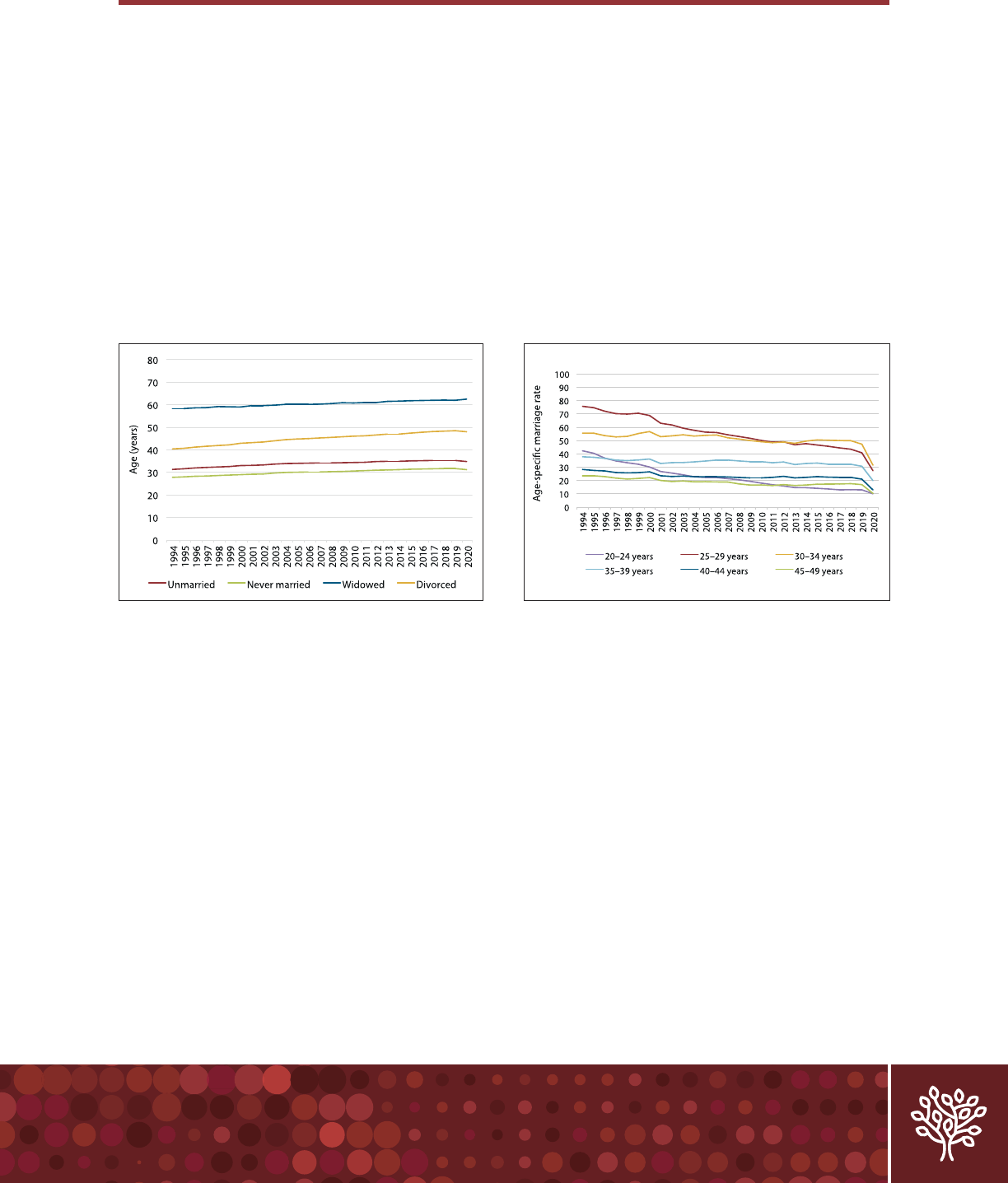
6 | THE VANIER INSTITUTE OF THE FAMILY
FAMILIES COUNT 2024 | FAMILY STRUCTURE
Why this matters
Since marriage often came before family life
in the past, it happened at much younger
ages. Many couples today are putting off
marriage because they want to pursue
other aspirations first. Even among those
who do choose to marry, most young
people now prefer to live together with
their partners as a way of “testing the
waters” before committing to marriage,
which has pushed up the average age
at marriage. Since the risk of divorce
decreases the older one gets married,
this shift could result in longer lasting
marriages, on average.
9
Average age at marriage, by legal marital
status prior to marriage, Canada, 1994–2020
Source: Statistics Canada. (2022, November 14). Mean age
and median age at marriage, by legal marital status.
8
Marriage rate per 1,000 unmarried persons,
by age group, Canada, 1994–2020
Source: Statistics Canada. (2022, November 14). Number
of persons who married in a given year and marriage rate
per 1,000 unmarried persons, by age group and legal
marital status.
10

FAMILIES COUNT 2024 | FAMILY STRUCTURE
7 | THE VANIER INSTITUTE OF THE FAMILY
Divorce rates are influenced by social,
economic, legal, and cultural trends. From
the late 1960s to the late 1980s, the number
of divorces in Canada increased sharply.
This was driven by a variety of factors,
including decreasing stigma against divorce
and the increasing economic independence
of women. Equally important was the
creation of the Divorce Act, 1968 and
amendments made in 1986 that made
it easier to obtain a divorce. Since the
early 1990s, however, divorce rates
have declined notably.
The number of divorces has fallen since the
early 1990s, from nearly 79,000 in 1991 to
57,000 by 2019.
11
In 2020, nearly 43,000
divorces were granted in Canada—the
lowest number since 1973.This decline
was largely due to disruptions in the court-
based process of granting divorces during
the COVID-19 pandemic.
The divorce rate (i.e., the number of
persons who divorce in a given year per
1,000 married persons) also declined
during this period. This dropped from
12.7 per 1,000 married people in 1991
to 7.5 per 1,000 married people in 2019,
before hitting a record low of 5.6 per 1,000
married people in 2020 during the early
months of the pandemic.
12
The aging of the married population is key
to understanding the decline in divorce
rates over time. Divorce rates tend to
be lower among older age groups. In
2020, there were 5.2 divorces per 1,000
married persons for those aged 50 to 64,
compared with 8.5 per 1,000 among
those aged 15 to 34.
11
Although the divorce
rate is higher for younger age groups, it has
also declined in recent years.
Younger couples today tend to follow
different trajectories than previous
generations regarding marital status. In
recent decades, a growing share of younger
people have been choosing common-law
unions rather than marriage. Since divorces
apply only to married and not to common-
law unions, a decreasing proportion of
couples getting married in a population
inevitably leads to a lower number of
divorces within that population.
5
Why this matters
Divorce statistics do not provide a complet
e
picture of relationships ending. In 2021,
more than one in five (22.7%) couple
relationships in Canada were common-
law.
5
This rate continues to increase and is
much higher in some parts of the country,
Divorce rates have declined
since the early 1990s
3
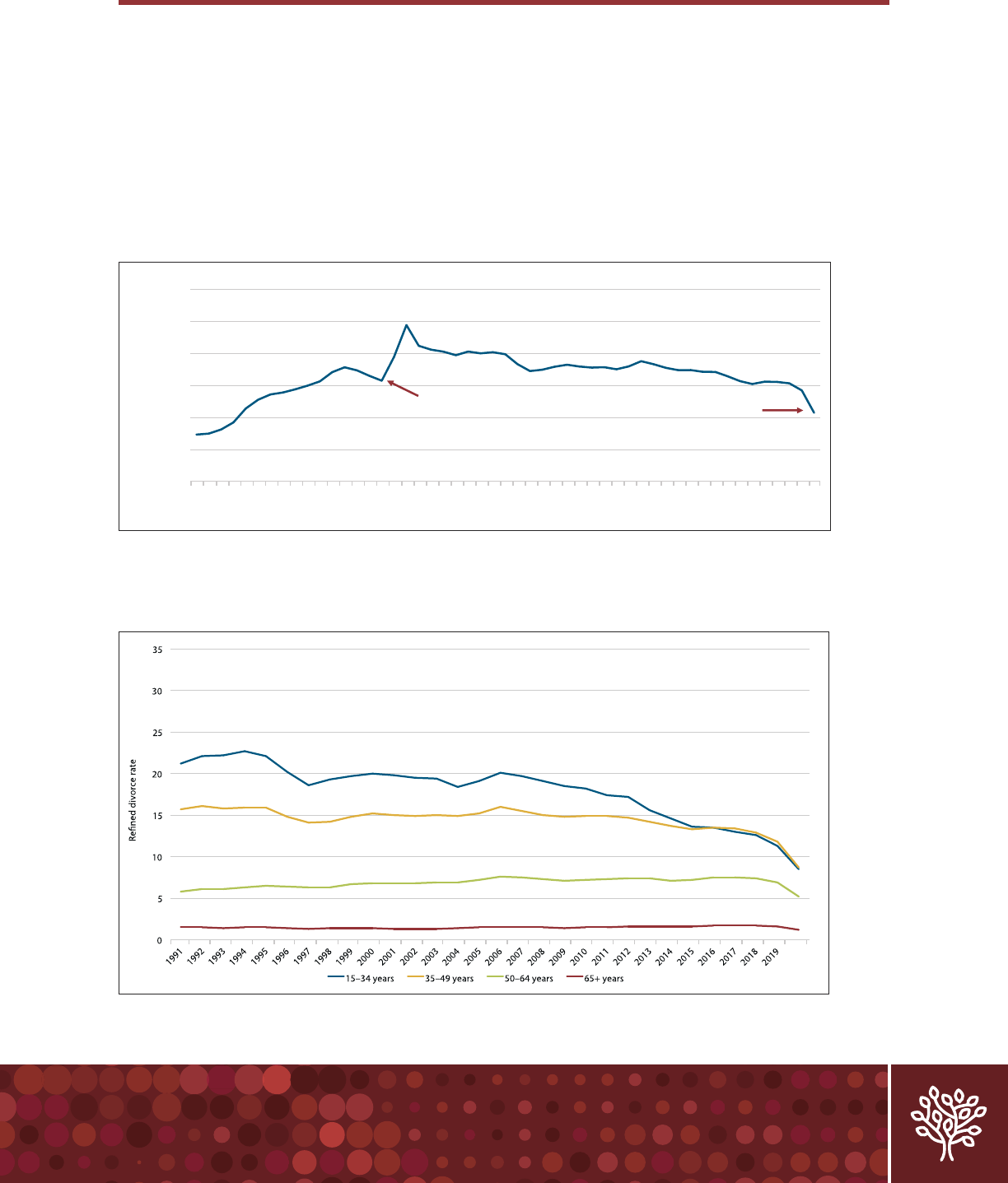
8 | THE VANIER INSTITUTE OF THE FAMILY
FAMILIES COUNT 2024 | FAMILY STRUCTURE
particularly in Quebec and Nunavut. When
common-law couples end their relationship,
it is not recorded in divorce data.
Even so, divorce statistics are valuable
indicators since most couples are married,
and therefore may experience a divorce in
their lifetime. Currently, they are some
of the only statistics to show that a
relationship has ended. Understanding
these trends is important because they
provide unique insights on topics at the
heart of family life, such as fertility,
finances, housing, and caregiving.
20,000
40,000
60,000
80,000
100,000
120,000
1970
1971
1972
1973
1974
1975
1976
1977
1978
1979
1980
1981
1982
1983
1984
1985
1986
1987
1988
1989
1990
1991
1992
1993
1994
1995
1996
1997
1998
1999
2000
2001
2002
2003
2004
2005
2006
2007
2008
2009
2010
2011
2012
2013
2014
2015
2016
2017
2018
2019
2020
Number of divorces
COVID-19
public health
measures
Divorce Act
amendments (1986)
Number of divorces, Canada, 1970–2020
Source: Statistics Canada. (2022, November 14). Number of divorces and divorce indicators.
12
Number of persons who divorced per 1,000 married persons (refined divorce rate)
by age group, Canada, 1991–2020
Source: Statistics Canada. (2022, March 9). A fifty-year look at divorces in Canada, 1970 to 2020. The Daily.
11

FAMILIES COUNT 2024 | FAMILY STRUCTURE
9 | THE VANIER INSTITUTE OF THE FAMILY
Compared with previous generations, far
more couples today are choosing to live
together without getting married. Younger
generations’ shift toward living common-law
before—and sometimes instead of—getting
married may sound unremarkable today
since much of this shift occurred decades
ago. It nonetheless signifies a major shift in
what families look like and how people think
about family life.
Individuals are considered to be in a
common-law relationship when they
cohabitate for a certain period of time (this
varies by province or territory), yet they have
not formalized their union through legal
marriage.
13
In 2021, Canada was home to
more than 1.9 million common-law couples,
representing nearly one-quarter (22.7%) of
all couples.
14
This is more than triple when
they were first counted in the 1981 Census
(6.3%).
15
Among G7 countries, Canada now
has the highest percentage of couples living
common-law.
5
More than one in five people
aged 15 and older (22.1%) were living
common-law in 2021, nearly four times
higher than in 1991 (6.7%).
1, 2
Canada’s high proportion of common-
law couples is driven by the even higher
prevalence found in Quebec. In 2021, more
than four in 10 couples (42.7%) were
common-law, compared with only 16.9%
outside of Quebec.
6
In addition to having
more than double the proportion of couples
living common-law, Quebec also saw a
much higher increase over time. The highest
proportion is in Nunavut, which became
the first province or territory in the country
with a majority (51.7%) of couples living
common-law in 2021.
Living common-law is more prevalent
among younger age groups, which reflects
an ongoing generational shift. In 2021,
nearly one-quarter (23.5%) of 25- to
29-year-olds lived common-law,
1
up from
14.0% in 1991.
2
The number of people
living common-law decreases after young
adulthood older in most parts of Canada.
The two exceptions are Quebec and
Nunavut, where living common-law is
more commonly chosen as an alternative
to marriage.
5
The 2017 General Social Survey asked
common-law partners who had indicated
that they did not intend to marry their current
partner why they did not want to get married.
Among those aged 25 to 34, the top two cited
responses were that the “current situation is
fine as is” (37.8%), followed by “don’t believe
in the institution of marriage” (24.3%).
17
The growing proportion of couples choosing
common-law over marriage is driven by a
Common-law unions are most
common in Quebec and Nunavut
4
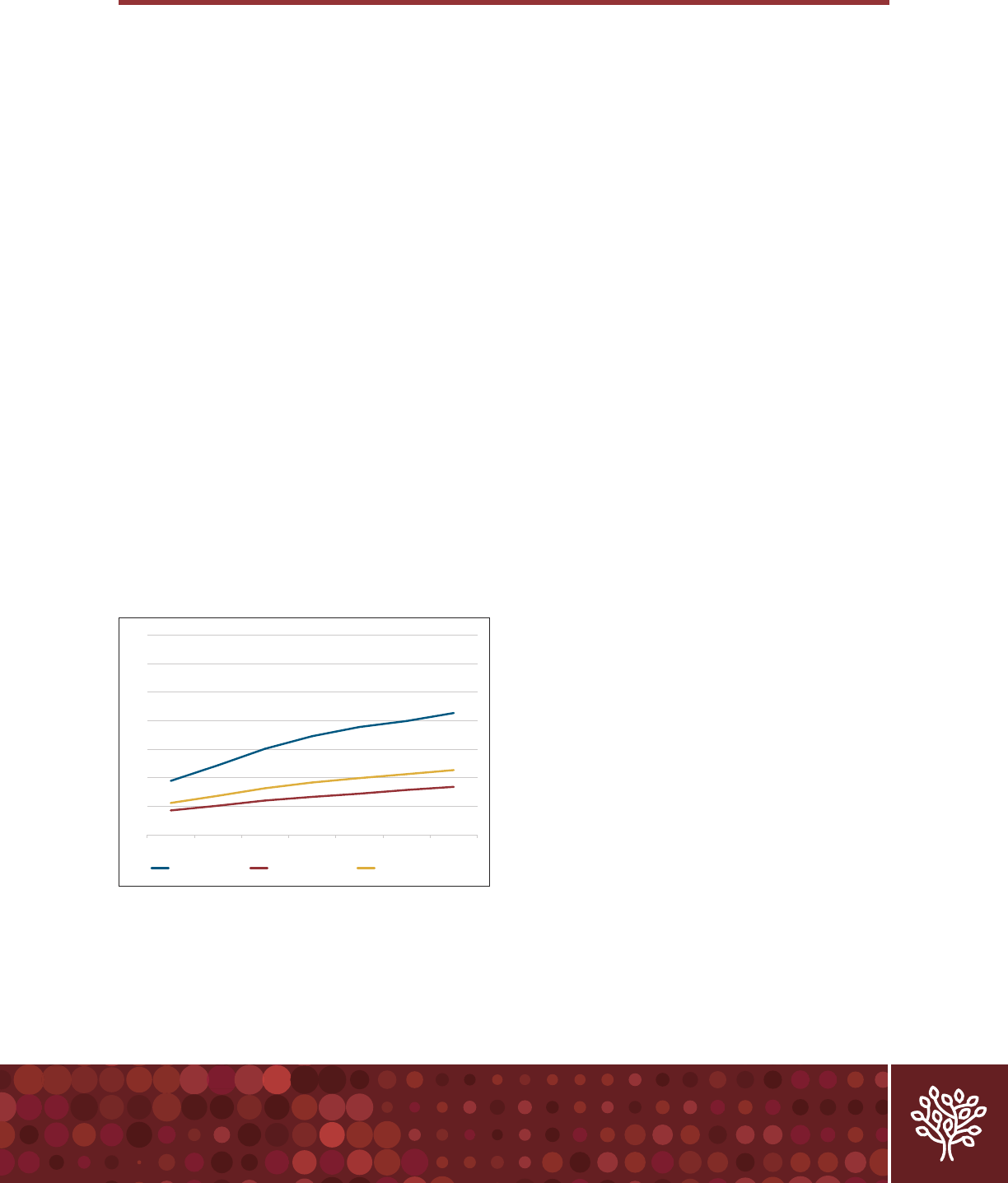
10 | THE VANIER INSTITUTE OF THE FAMILY
FAMILIES COUNT 2024 | FAMILY STRUCTURE
variety of factors, including the declining
influence of religion on society, broadened
divorce legislation, improved access to
contraception, and increasing educational
attainment and labour force participation of
women. This shift has been most pronounced
in Quebec, where the influence of the Catholic
Church has declined greatly since the 1960s.
The higher prevalence of common-law
unions in Nunavut is associated with the
characteristics of its population, which is
younger and largely Indigenous (84.3%
of its population in 2021 were Inuit
18
).
Why this matters
Many people assume that common-law
couples have the same rights as married
couples. While Canadian law has
increasingly treated both couple types the
same, their rights and obligations, as well
as the definition of “common-law,” vary
across provinces and territories. For example,
married people are eligible for spousal
support, division of property in the case of
separation and divorce, or inheritance in case
of death, but the portrait is far more complex
for people in common-law relationships. If a
common-law couple separates in Ontario,
Quebec, New Brunswick, Nova Scotia, Prince
Edward Island, Newfoundland and Labrador,
or Yukon, there is no legal obligation for
the partners to divide their property as a
married couple.
19
As couples continue to
opt for living common-law, issues such
as these may affect a growing number of
people in Canada.
19.0
42.7
8.6
16.9
11.2
22.7
1991 1996 2001 2006 2011 2016 2021
Percentage of couples
Inside Quebec Outside Quebec Canada (average)
Percentage of all couples that were
common-law, inside Quebec and outside
Quebec, 1991–2021
Sources: Statistics Canada. (2008, February 19). Number of
children at home (8) and census family structure (7) for the
census families in private households of Canada, provinces,
territories, census divisions, census subdivisions and
dissemination areas, 2006 Census – 20% sample data.
20
Statistics Canada. (2013, December 23). Number of children
at home (8) and family structure (7A) for census families in
private households, for Canada, provinces and territories,
1981 to 2001 censuses – 20% sample data.
21
Statistics Canada. (2018, May 30). Census family structure
(7) and presence and ages of children (15) for census
families in private households of Canada, provinces and
territories, census metropolitan areas and census
agglomerations, 2016 and 2011 censuses – 100% data.
22
Statistics Canada. (2022, July 13). Census family structure,
presence of children and average number of persons per
census family: Canada, provinces and territories, census
metropolitan areas and census agglomerations.
6

FAMILIES COUNT 2024 | FAMILY STRUCTURE
11 | THE VANIER INSTITUTE OF THE FAMILY
Approximately one in 10 people in Canada
are in an intimate relationship but do not
live with their partner, in what is known as
a living apart together (LAT) couple.
23
Also
known as non-cohabitation, LAT is both a
living arrangement and one of the many
forms of structural diversity found among
families in Canada. Researchers have paid
growing attention to LAT couples as couples
have become increasingly diverse and this
living arrangement becomes more common.
Data from the 2017 General Social Survey
(GSS) show that nearly 1.5 million people
aged 25 to 64 were in a couple
a
with
someone living in a different residence.
23
This accounted for 9% of all people in
couples, up from 6% in 2006. Living apart
together is most common among younger
age groups: among those in couples, 20%
of 25- to 34-year-olds, 7% of 35- to 54-
year-olds, and 5% of 55- to 64-year-olds
lived apart in 2017.
Among those in LAT couples in 2017, 15%
said that they had never considered living
together, while 34% said it was a choice to
live apart.
23
Just over half (51%) cited “other
circumstances”
b
as the reason they did not
live together, which included schooling,
financial situations, and work.
There are many reasons why couples may
choose to continue living apart, though it is
often a transitionary phase that eventually
leads to living together. According to the
2011 GSS, seven in 10 people in LAT couples
said that they intended to live together
eventually, while 15% were uncertain and
14% said they did not intend to live together
(this data is not available for 2017).
24
The
proportion who intended to live together
decreased with age, from 83% of 20- to
24-year-olds in LAT relationships to only
28% for those aged 60 and older.
a
In 2011, the most frequently cited reason
among this group for choosing to live
separately was that they were “not yet ready
for living together” (48%), indicating that
their LAT status was transitional. Nearly
three in 10 people (28%) who chose to live
in an LAT couple said they did so to “keep
independence.”
a
Why this matters
Couples living apart is by no means a new
phenomenon, although it has become more
commonplace in recent decades. LAT
couples are more frequent among young
adults as they navigate school, work, and
social life. People who have previously been
Living apart is increasingly
common among couples
5

12 | THE VANIER INSTITUTE OF THE FAMILY
FAMILIES COUNT 2024 | FAMILY STRUCTURE
married may wish to maintain financial
autonomy and avoid intertwining their
debt or wealth with a new partner, or
they may simply not feel any pressure
to live together.
Regardless of their age, many people who
choose to live apart together do so to
experience the connection and intimacy
of being in a couple while maintaining the
independence of living apart. There may
be important considerations that need
to be managed or otherwise addressed
by couples living apart, such as how
caregiving is provided across households.
25
33.4
20.2
6.2
32.8
16.8
3.9
33.8
23.1
12.1
20–34 years 35–64 years 65+ years
Percentage
Total Women Men
Proportion of the population living alone in a living apart together
(LAT) relationship, by age group and gender, Canada, 2017
Source: Tang, J., Galbraith, N., & Truong, J. (2019, March 6). Living alone in Canada.
Insights on Canadian Society.
26
a
Includes those in living-apart-together relationships who were married, single (never married), widowed, divorced, or separated.
b
A breakdown of the percentage of respondents citing these examples is not available.

FAMILIES COUNT 2024 | FAMILY STRUCTURE
13 | THE VANIER INSTITUTE OF THE FAMILY
Polyamorous families are one of the growing
number of diverse family structures in
Canada. Polyamory is a form of consensual
non-monogamy (CNM). This umbrella term
describes any type of intimate relationship
in which the partners allow sexual and/or
emotional relationships outside their
couple relationship.
27
While some of these
relationship types are focused on the partners
allowing for sexual experiences outside the
couple without romantic or emotional
attachments, polyamory is distinguished
from other CNM relationship types in that
it allows for them.
Like all relationships, polyamorous
relationships
are diverse. The specific
structures, the types of relationships
(e.g., sexual and/or romantic,
regular, or
infrequent), and the roles and expectations
within can vary greatly depending on the
preferences of the people involved. Some
polyamorous families are centred around
long-term, committed relationships
with
two or more people, while others may
have a mix of short-term and long-term
relationships with varying degrees of
intimacy and commitment.
28
Polyamorous relationships may include—but
do not require—a married or common-law
couple, but Canadian law does not recognize
intimate relationships between more than
two people. Since polyamorous relationships
are not counted in the Census nor included
in the definition of a census family household,
there is a data gap in their prevalence and
composition. Surveys have shown that
approximately one in five people in Canada
and the United States have practised
consensual non-monogamy at some point,
with young adults more likely to have done
so.
27
Research shows that sexual minorities
are more likely to practise CNM than
heterosexual people.
29
Polyamorous families are increasingly being
recognized in Canadian law. This has resulted
from legal cases in which more than two
people in a polyamorous relationship shared
parental responsibilities but faced difficulties
because their family structure was not being
recognized in most law or policies. For
example, the Divorce Act defines “spouse”
as “either of two persons who are married
to each other,” while the Civil Marriage Act
provides that marriage is “the lawful union of
two persons to the exclusion of all others.”
30
Several court cases in recent years have
broadened parental rights to also include
families with more than two parents and
addressed the exclusion of polyamorous
families from Canadian law. In 2018, three
unmarried adults in a relationship in
Newfoundland and Labrador were declared
legal parents of a child born within their
polyamorous family. Because the provincial
Polyamorous families have
broadened family law
6

FAMILIES COUNT 2024 | FAMILY STRUCTURE
14 | THE VANIER INSTITUTE OF THE FAMILY
Children’s Law Act did not allow for more than
two people to be named as the legal parents
of a child, only two could be listed on the
child’s birth certificate. In his ruling, Justice
Robert Fowler of the Newfoundland and
Labrador Supreme Court’s family division
said that “Society is continuously changing
and family structures are changing along
with it.
31
This must be recognized as a
reality and not as a detriment to the best
interests
of the child.”
In 2021, a British Columbia court ruled that
a second mother in a polyamorous family be
added to a child’s birth certificate. Justice
Sandra Wilkinson echoed Fowler’s ruling,
stating “I find that there is a gap in the [Family
Law Act
32
]... Put bluntly, the legislature did not
contemplate polyamorous families.” She said
that it was in the “best interests [of the child]
to have all of his parents legally recognized
as such.”
Why this matters
This lack of alignment between the diversity
of families and the laws that affect them can
have an impact on wellbeing; these families
often must navigate and interact with systems
and institutions that were not designed to
support them. This was underscored in a
2021
study in which polyamorous parents
in Canada who had recently given birth (or
been a partner to someone who did) reported
experiencing conflict with, or exclusion from,
aspects of social systems designed for
monogamous couples/families.
33
Other research shows that parents in
polyamorous families also report challenges
and difficulties regarding parenting and family
dynamics, including social acceptance and
legal protection, coming out to children,
time management, and reconciling family
obligations with personal needs.
27
Some
of these issues may dissipate in future
generations if greater awareness and
discussion act to reduce stigma and/or
if family law continues to become more
inclusive of diverse family structures. Many
parents in polyamorous families also cited
strengths of their family structure, such
as having a larger support network for
themselves and their children.
Despite the small body of research on
polyamorous families in Canada, there
is growing awareness and discussion of
non-traditional relationship types, including
polyamory and other forms of consensual
non-monogamy. Polyamorous families are just
one of many forms of structural diversity that
make families unique. The struggles for legal
recognition of parents in these families
highlight how laws and policies often trail
social change. It remains to be seen how
these developments may reshape or
otherwise impact family justice policies,
legislation, and training for service providers.
34
Further research will play an important role in
strengthening understanding of polyamorous
families and ensuring they are included in
laws and policies.
Different versions of the pride flag, designed by Red Howell
in 2022 (left),
35
and by Jim Evans in 1995 (right).
36

FAMILIES COUNT 2024 | FAMILY STRUCTURE
15 | THE VANIER INSTITUTE OF THE FAMILY
Young adults have become more likely to
live with parents over the last 30 years.
Census data show that, in 2021, nearly half
(45.8%) of those aged 20 to 29 lived with
at least one parent.
37
Living with parents
into young adulthood is done out of
neccessity, out of preference, or both.
38
In 1991, 32.1% of those in their twenties
lived with parents.
39
This includes both
young adults who never left and those
who returned home after living elsewhere.
As was the case 30 years ago, men were
more likely than women in their twenties to
live with parents in 2021 (49.4% vs. 42.0%,
respectively).
37
Men (64.6%) and women
(59.3%) aged 20 to 24 were more likely to
live with parents than those aged 25 to 29
(35.2% and 26.7%, respectively).
Across provinces and territories, the highest
percentages of people in their twenties
living with parents in 2021 were in Nunavut
(54.7%) and Ontario (53.3%).
37
These
were the only provinces/territories above
the national average. Living with parents
was least commonly reported among those
living in the Yukon (33.8%), Nova Scotia
(36.4%), and Saskatchewan (36.9%).
Several factors contribute to these
geographical differences. Housing often
plays a role. The availability and adequacy
of housing has been a long-standing issue
in Nunavut, for example, where the highest
percentage of young adults live with parents.
In large urban centres like Vancouver and
Toronto, the cost of renting or buying a
home is a driving factor for young adults
living with parents.
Compared with rural areas, large urban
centres are also home to a greater proportion
of immigrant families, who are more likely
to live with parents.
38
Data from the 2011
National Household Survey showed that
immigrant young adults in their twenties
were more likely than non-immigrants to
live with their parents (50% vs. 42%).
39
Why this matters
Living with a parent can be a valuable source
of emotional, logistical, and financial support
.
This is especially true when pursuing
education, after a relationship break-up
or separation, when there are fewer job
opportunities, or when there are economic
disruptions. Living with parents can be a
strategy for dealing with low employment
earnings, job loss, or the high cost of living.
Others may choose this living arrangement
to provide or receive care across generations.
Young adults are more likely
to live with parents
7

FAMILIES COUNT 2024 | FAMILY STRUCTURE
16 | THE VANIER INSTITUTE OF THE FAMILY
Indeed, the most recent data on the topic
show that, in 2012, 9.0% of young adults
aged 20 to 34 who were usually living with
their parent(s) were the primary caregiver
for one or both parents.
40
Several factors may explain the increase in
the number of young adults living with their
parents, including the higher percentage of
young people now pursuing postsecondary
education, whose student debt often
results in greater economic dependence.
Living with a parent also does not come
with the same stigma it used to in
previous
generations, which removes
a social deterrent
from choosing this
living arrangement.
50.5
16.9
62.0
31.0
20–24 years 25–29 years
Percentage
1991 2021
Percentage of the population aged 20 to 29 living with at least
one parent, by age group, Canada, 1991 and 2021
Sources: Milan, A. (2016, June 15). Diversity of young adults living with their
parents. Insights on Canadian Society.
39
Statistics Canada. (2022, July 13). Census family status and household living
arrangements, presence of parent in household, age group and gender: Canada,
provinces and territories, census metropolitan areas and census agglomerations.
37

FAMILIES COUNT 2024 | FAMILY STRUCTURE
17 | THE VANIER INSTITUTE OF THE FAMILY
Multigenerational households (those
housing three or more generations) have
never been a dominant living arrangement
in Canada. However, they have become one
of the fastest
growing household types in
recent decades
.
In 2021, there were more than 442,000
multigenerational households in Canada,
41
home to 2.4 million people, or 6.4% of the
total population.
42
These households have
grown in number by 21.2% since 2011—
much higher than the overall increase of
12.4% observed among all households.
41
A growing share of children under 15 are
living with grandparents, from 8.5% in 2011
to 9.1% in 2021 (93.3% of whom were living
in multigenerational households).
42
Data from the 2021 Census show that
Indigenous and immigrant families—
two fast-growing population groups—
are more likely than others to live in
multigenerational households. Provinces
and territories with relatively higher
proportions of Indigenous and/or immigrant
children under 15 had the highest percentage
of children who lived with grandparents.
This included Nunavut (21.3%), British
Columbia (13.1%), Ontario (11.8%), and
the Northwest Territories (9.4%).
43
Census
metropolitan areas
a
with the highest
proportion of multigenerational households
were also home to some of the highest
percentages of immigrants in the country,
such as in Abbotsford-Mission (22%),
Brampton (28%), and Markham (23%).
Among children under age five, 10.4% lived
with at least one grandparent in 2021.
43
This proportion was more than twice as
high among First Nations (19.7%) and
Inuit (24.6%) children than among non-
Indigenous children (9.8%). Among the
Métis children in this age group, 9.4% lived
with at least one grandparent.
The higher likelihood of living in a
multigenerational household also
reflects the fewer options immigrant and
Indigenous families may have to choose
from. Most immigrant families first arrive
in major urban centres, which also tend to
have the highest housing prices. In 2021,
multigenerational households were the
most common living arrangement among
First Nations people living in crowded
housing (34.5%).
44
Multigenerational households
are one of the fastest growing
household types
8

FAMILIES COUNT 2024 | FAMILY STRUCTURE
18 | THE VANIER INSTITUTE OF THE FAMILY
Why this matters
Some families live in multigenerational
households because it can help with care
and caregiving between generations.
Multigenerational households often include
someone with an activity limitation.
45
In
addition, many grandparents who live with their
grandchildren provide care when the parents
are at work, at school, or running errands. This
can help families with certain childcare costs,
something with which many parents struggle.
There are many complex reasons for the
increase in multigenerational households.
Through income-pooling, the cost-saving
advantages in these households can
be important for recent immigrants
and their families as they adapt to
their new country and build connections.
Some families may also already have a
cultural preference for living with multiple
generations. Families from all backgrounds
may also choose to live in multigenerational
households when they include new and
expectant parents.
Even so, multigenerational living is not
for everyone, and living with multiple
generations sometimes happens out
of necessity, not choice. This can result
in unsuitable living arrangements, such
as crowded housing, which is known
to affect wellbeing.
46
a
A census metropolitan area is a large urban centre with a population of at least 100,000 with 50% living in the core.
PE
Percentage of the population living in a multigenerational household, Canada, 2021
Source: Statistics Canada. (2022, July 13). Census family status and household living arrangements, household type of person,
age group and gender: Canada, provinces and territories, census metropolitan areas and census agglomerations.
42

FAMILIES COUNT 2024 | FAMILY STRUCTURE
19 | THE VANIER INSTITUTE OF THE FAMILY
Stepfamilies have always been a part
of Canada’s family landscape, but the
circumstances leading to their formation
have changed across generations. Similar
to a shift that has occurred among
one-parent families, stepfamilies used to
typically form after the death of a spouse
or partner. In today’s context of relatively
higher divorce rates and lower mortality
(particularly maternal mortality),
they now usually form after divorce
or separation.
47
The 2021 Census data showed there
were more than 500,000 stepfamilies in
Canada.
48
A stepfamily is a couple family
with children that contains at least one
child (biological or adopted) of only one
of the spouses/partners whose birth
or adoption preceded the current
relationship. The spouses/partners in
stepfamilies can be married or living
common-law.
In 2021, 8.4% of all couple families with
children of any age were stepfamilies,
down slightly from 9.0% in 2011.
48
Nearly
four in 10 (39%) same-gender couples
with children of any age in 2021 were
stepfamilies, compared with 12% of
different-gender couples with children.
5
Stepsiblings are defined in the Census as
siblings who live in the same household
but do not have the same birth or adoptive
parents. Half-siblings, on the other hand,
are siblings who live in the same household
and share one common birth or adoptive
parent.
a
In 2021, approximately two-thirds
(65.2%) of children aged 0 to 14 in
stepfamilies had at least one half- or
stepsibling.
38
The remaining 37.5%
had neither.
Among couples with children, those living
in a common-law relationship in 2021
were more than four times as likely to
be stepfamilies (31.0%) as their married
counterparts with children (7.3%).
48
This
suggests that parents may prefer to live
common-law when they re-partner.
Why this matters
Becoming a stepfamily is a significant life
change that affects all family members.
Spouses or partners take on the role of
stepparents, children gain new siblings,
and a relocation to a different home
often occurs. As the family adapts,
responsibilities and relationships undergo
transformation, and it may take several
Pathways to becoming a
stepfamily have evolved
9
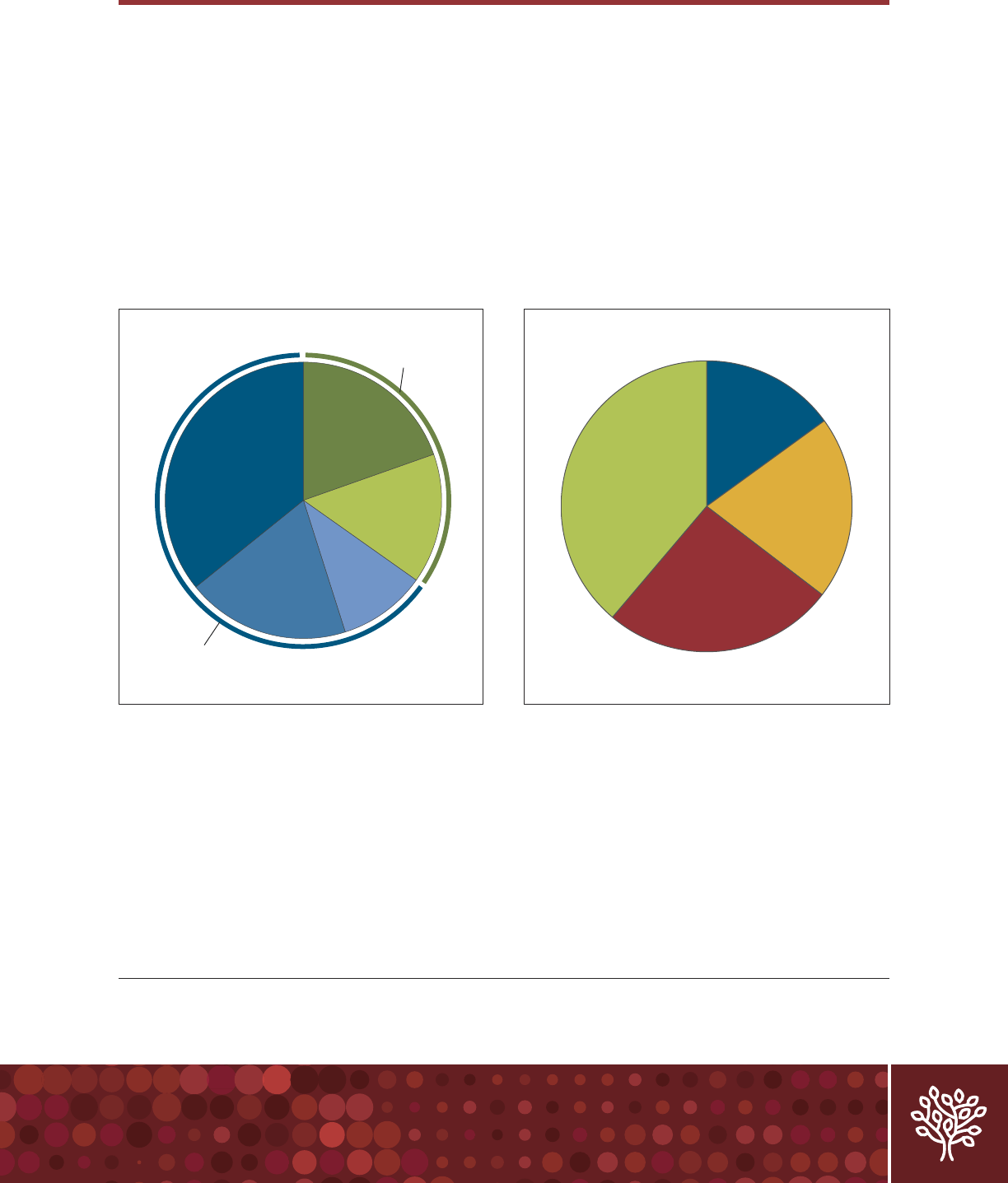
FAMILIES COUNT 2024 | FAMILY STRUCTURE
20 | THE VANIER INSTITUTE OF THE FAMILY
years for the stepfamily to identify as
a unified family.
In the past, stepparents were often
depicted negatively in popular culture and
folklore, portraying them as wicked figures
who mistreated their stepchildren. The
image of the stepparent has undergone a
significant transformation over the years,
evolving from a negative stereotype to
being recognized as a valued second parent.
Despite this shift, policy makers and courts
are still grappling with the complexities that
stepfamilies present, especially around the
rights and responsibilities of stepparents.
a
In this context, adoptive children are treated the same as biological children.
With no stepsiblings
or half-siblings
34.8%
With at least one
stepsibling or half-sibling
65.2%
With a
stepmother
10.3%
With a stepfather
19.1%
With a stepmother
15.2%
With a stepfather
19.6%
With two biological or
adoptive parents
35.8%
Living arrangements of children under 15 living
in stepfamilies, Canada, 2021
Statistics Canada. (2022, July 13). Home alone: More
persons living solo than ever before, but roomies the
fastest growing household type. The Daily.
38
0–4 years
15.0%
5–9 years
20.4%
10–14 years
25.8%
15–24 years
38.8%
Distribution of children under 15 living in
stepfamiles, by age group, Canada, 2021
Statistics Canada. (2022, July 13). Home alone: More
persons living solo than ever before, but roomies the fastest
growing household type. The Daily.
38

FAMILIES COUNT 2024 | FAMILY STRUCTURE
21 | THE VANIER INSTITUTE OF THE FAMILY
Women in Canada now have fewer
children on average than in past
generations. This shift can be seen in the
decline in the total fertility rate (average
number of children per woman) over the
past half-century. After reaching an all-
time high of 3.94 children per woman in
1959
50
during the peak of the baby boom,
the total fertility rate (TFR) declined
sharply until the late 1980s.
51
It then
fluctuated over the next 20 years until
starting another long-term decline in
2009 that continues to this day (except
for a small temporary increase in 2021).
The most recent data show a new record
low was reached in 2022 at 1.33 children
per woman.
The reasons for this long-term decline
are complex. They include the growing
participation of women in higher education
and in the paid labour force, increased
effectiveness and availability of contraception,
and the decreased influence of religion on
daily life.
50
The percentage of women aged
25 to 54 with a postsecondary certificate/
diploma more than doubled from 28.3%
in 1990
52
to 74.5% in 2021.
53
During the
same period, the labour force participation
rate of women aged 25 to 54 increased
from 75.5% to 84.2%.
54
People’s decisions about childbearing can
be affected by the uncertainty resulting
from major events or changes in broader
social, political, environmental, or health
circumstances. For example, survey data
from April to June 2021 showed that 23.5%
of the population aged 15 to 49 changed
their fertility plans because of the COVID-19
pandemic.
55
Nearly one in five (19.2%) said
they now wanted to have fewer children
than previously planned, or to have a
baby later than previously planned.
Declining fertility rates also coincide with
changing patterns in the age of mothers.
50
The average age of first-time mothers
increased from 26.2 years in 1994 to a
record high of 29.4 years in 2019.
56
While
age at first birth declined for all age groups
under 30, it increased for those aged 30
and older.
50
Meanwhile, fertility among
young women aged 15 to 19 dropped
from 25.1 per 1,000 live births in 1994
to 4.4 per 1,000 live births by 2022.
51
Fertility rates vary across the country. Since
it was created in 1999, Nunavut had had
the highest total fertility rate in Canada
(2.23 children per woman in 2022), followed
by Saskatchewan (1.69), Northwest
Territories, and Quebec (1.49 each).
51
Fertility rates hit a record
low (again)
10

FAMILIES COUNT 2024 | FAMILY STRUCTURE
22 | THE VANIER INSTITUTE OF THE FAMILY
The lowest fertility rates in 2022 were in
British Columbia (1.11) and Nova Scotia
(1.18).
Why this matters
Policymakers and researchers closely
monitor fertility rates because major shifts
can affect families, the labour market, and
the economy. For families, fewer children
mean there are fewer people to provide
care and support within and across
generations. It also means that
intergenerational transfers of wealth
(e.g., inheritances, family support for
major life expenses, etc.) could be
increasingly concentrated in fewer hands
in the coming years.
Smaller numbers of babies being born will
result in fewer workers entering the labour
market in the future. Therefore, the labour
market could become increasingly reliant
on immigration to maintain a balance of
older and younger workers. Tracking
fertility rates can inform long-term policy
and program development, such as
immigration targets, family allowances,
subsidized childcare, pension plans,
and compassionate care benefits.
0.0
0.2
0.4
0.6
0.8
1.0
1.2
1.4
1.6
1.8
2.0
2.2
2.4
Total fertility rate
Average number of children per woman (total fertility rate), Canada, 1972–2022
Sources: Statistics Canada. (2018, May 17). Fertility: Fewer children, older moms. Canadian Megatrends.
50
Statistics Canada. (2023, September 27). Crude birth rate, age-specific fertility rates and total fertility rate (live births).
51

FAMILIES COUNT 2024 | FAMILY STRUCTURE
23 | THE VANIER INSTITUTE OF THE FAMILY
One-parent families are more common
than they were 30 years ago, but their
growth has stabilized over the last decade.
Also known as lone-parent, single-parent,
and solo-parent families, their prevalence
has fluctuated throughout Canada’s
history due to shifting social, economic,
and cultural factors.
In 2021, one-parent families represented
16.4% of census families.
6
This is up from
1991 (13.0%), although the proportion has
been stable since 2011 (16.3%).
57
In 2001,
part of the increase was the result of a
change in the definition of the census
family used for that census questionnaire
(and all since).
58
The highest proportion of one-parent
families in 2021 was in Nunavut (33.1%) and
the Northwest Territories (23.4%), while the
lowest was in British Columbia (14.9%).
48
That year, nearly one in five children
under 15 across Canada (19%) lived in
a one-parent family.
38
Most parents in one-parent families are
women (77.2% in 2021).
48
Even so, the
proportion that are fathers has increased
in recent decades, from 17.3% in 1991
59
to
22.8% in 2021.
48
This is similar across the
country, except in Quebec (26.0%) and
in the territories, where the proportion of
fathers in one-parent families was 30.4%
in Nunavut and 26.8% in Yukon and the
Northwest Territories.
One-parent families are not new, but their
circumstances have changed over time. In
th
e early 20th century, the most common
pathway to becoming a one-parent family was
through the death of a parent. As mortality
rates declined across generations, so did
the prevalence of one-parent families.
57
The creation of the Divorce Act, 1968, along
with amendments to the Act in 1986, made
it easier to divorce. Both contributed to
spikes in the growth rate of one-parent
families. Before these reforms—and when
marriage rates peaked immediately
following Canada’s baby boom—one-
parent families represented a record-low
8.2% of census families in 1966.
57
Women’s increasing labour force
participation also strengthened mothers’
abilities to raise children on their own.
Fathers represent a
growing share of parents
in one-parent families
11
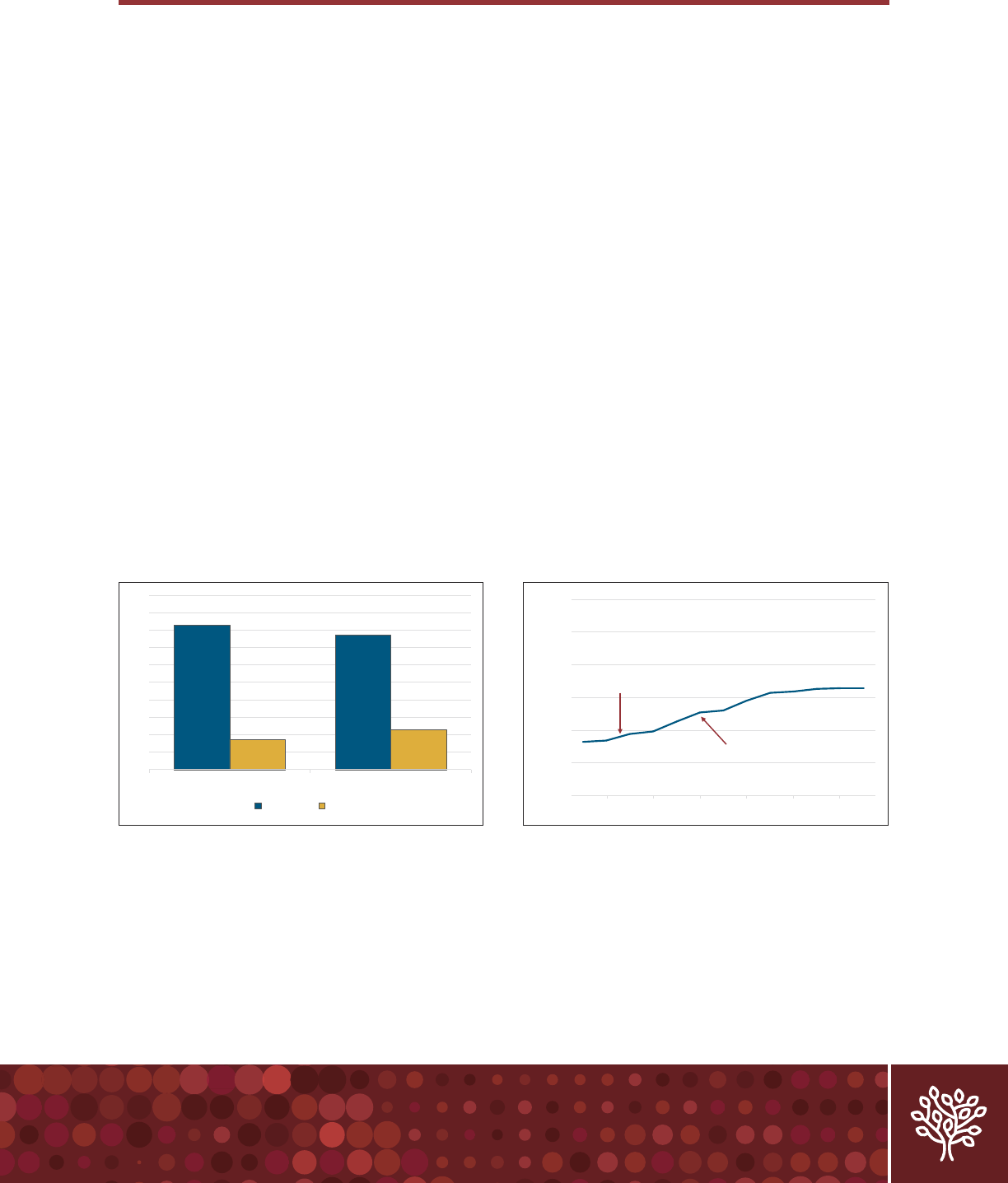
FAMILIES COUNT 2024 | FAMILY STRUCTURE
24 | THE VANIER INSTITUTE OF THE FAMILY
Why this matters
One-parent families have always been
a part of Canada’s family landscape, as
families transition out of being couple
families following divorce or the death
of a partner. Sometimes they result from
a conscious choice to raise a child or
children without another parent, although
there is no Canadian data on this topic.
Poverty is a notable concern for
one-parent families. They often face
economic challenges due to only having
one earner, along with the financial
responsibilities of raising children. Many
face difficulties accessing affordable
housing and childcare.
60
One-parent
families with children aged 5 and
under are approximately five times more
likely than couples with children of the
same age to experience poverty.
61
To lessen financial hardship among one-
parent families, federal and provincial
governments have implemented social
support programs such as income
assistance, childcare subsidies, and tax
benefits. Following this, poverty rates for
individuals living in one-parent families
led by a woman with a child aged five and
under decreased from 62.7% in 2015 to
31.3% in 2020.
61
Still, even in 2020, the
poverty rate for parents in one-parent
families with young children was much
higher than for couple families.
82.7
77.2
17.3
22.8
1991 2021
Percentage
Mothers Fathers
One-parent families led by mothers and
fathers, Canada, 1991 and 2021
Sources: Statistics Canada. (1996). Census families in private
households by age groups of youngest never-married child
at home (10), showing family structure (7), for Canada,
provinces, territories and census metropolitan areas, 1991
and 1996 censuses (20% sample data).
59
Statistics Canada. (2022, July 13). Census family structure
including detailed information on stepfamilies, number of
children, average number of children and age of youngest
child: Canada, provinces and territories, census metropolitan
areas and census agglomerations.
48
0
5
10
15
20
25
30
1961 1971 1981 1991 2001 2011 2021
Percentage
Divorce Act, 1968
Divorce Act
amendment
(1986)
Percentage of all census families that were
one-parent families, Canada, 1961–2021
Source: Statistics Canada. (2012, September). Fifty years of
families in Canada: 1961 to 2011. 2011 Analytical products.
57
Statistics Canada. (2022, July 13). Census family structure
including detailed information on stepfamilies, number of
children, average number of children and age of youngest
child: Canada, provinces and territories, census metropolitan
areas and census agglomerations.
48

FAMILIES COUNT 2024 | FAMILY STRUCTURE
25 | THE VANIER INSTITUTE OF THE FAMILY
According to the Children’s Aid Foundation
of Canada, approximately 2,000 children
under the care of child welfare agencies in
Canada find a new home with an adoptive
family every year.
62
Adopted children often
gain new siblings, with data from the 2011
General Social Survey (the most recently
available data on the topic) showing that
the majority (59%) of adoptive parents also
had at least one biological child.
63
Legally, adoption ends the responsibilities
of birth parents toward their child and
replaces them with new legal bonds
connecting the child to the adoptive
parents. Adoptions can occur whether
the birth parents and adoptive parents
live in the same province or territory,
across different provinces or territories,
or between Canada and another country
through an international adoption.
There are three main pathways to adopt
a child that was born in Canada. The first
option is through the public child welfare
system, which finds homes for children who
are in permanent government care. This is
available in all provinces and territories and
is publicly funded. Children undergoing this
process often come from foster care.
Alternatively, some children are adopted
through private adoption agencies, which
connect the birth parent(s) with people who
wish to adopt. Currently only available in
British Columbia,
64
Alberta,
65
Manitoba,
66
and Ontario,
67
private adoptions are
not publicly funded and typically cost
several thousands of dollars. Lastly, in
New Brunswick,
68
biological parents
can actively participate in finding an
adoptive family for their child.
The adoption pathway is different in
Indigenous communities, where “custom
adoptions” are frequent. Custom adoption
is the cultural practice by which birth parents
and adoptive parents make arrangements
directly with each other, without involving
an adoption agency. By its nature, customary
adoption varies from one community to
another, but it is common for biological
parents to maintain a role in the child’s
life after adoption.
68
A detailed national portrait of adoption in
Canada is difficult because child welfare
works differently across provinces and
territories. The same is true for international
adoptions, with adoption criteria varying
from one province or territory to another.
69
Thousands of children are
adopted every year but far
more need homes
12
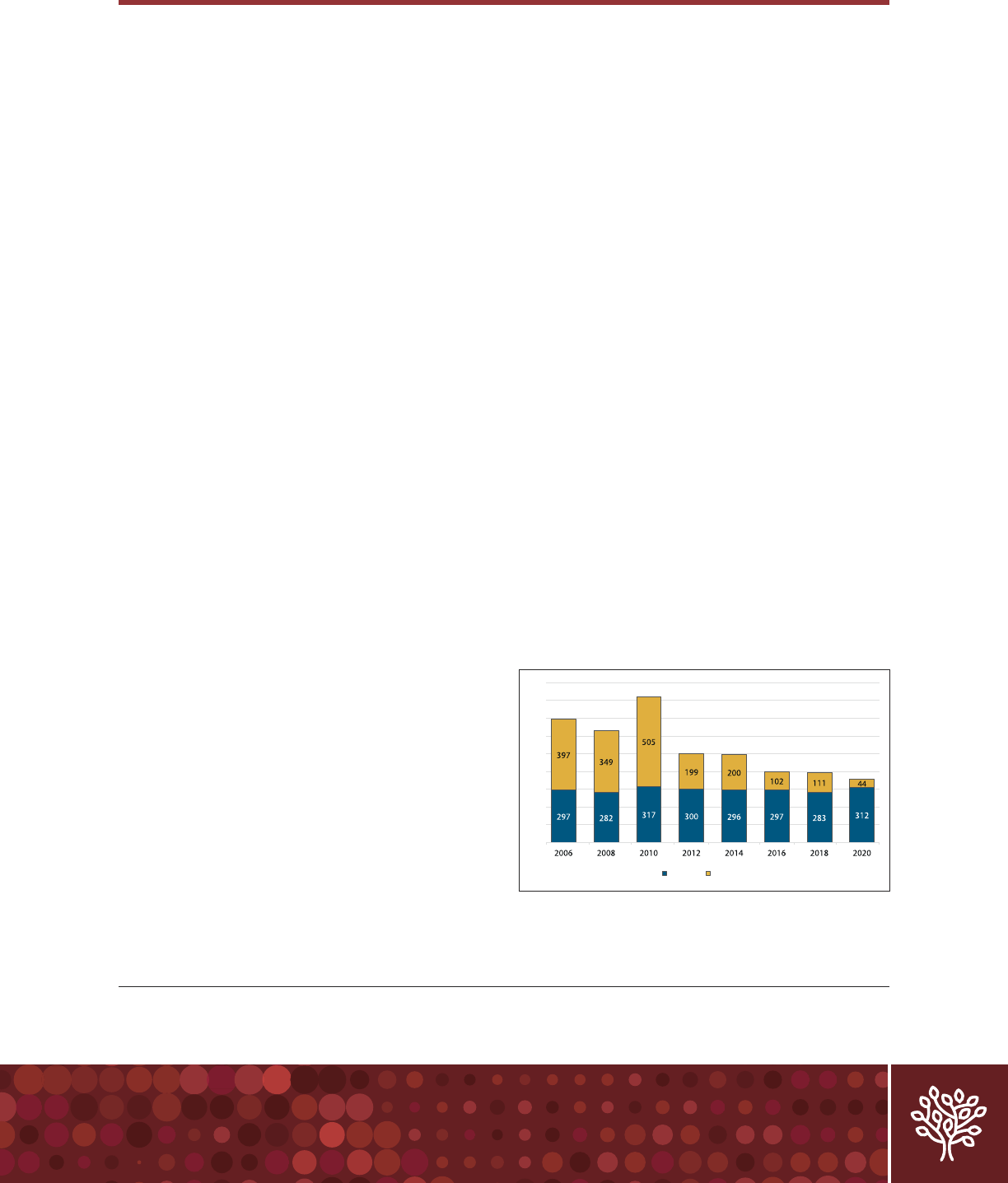
FAMILIES COUNT 2024 | FAMILY STRUCTURE
26 | THE VANIER INSTITUTE OF THE FAMILY
Currently, only Quebec maintains centralized
data on both provincial and international
adoptions in the province.
a
One reason for
this distinction is that since 2006, Quebec
has provided adoption-specific benefits
through the Quebec Parental Insurance Plan
(QPIP). Until 2024, these particular benefits
for adoptive parents were not available in
other provinces and territories.
Why this matters
Adoptive families in Canada play an
important role in helping children in need
with stable, caring environments. While this
makes a major difference to the lives of the
2,000 children who find new homes every
year, they represent fewer than one in 10
of the 30,000 children who are eligible for
permanent adoption.
62
But this is only the
tip of the iceberg, as more than 63,000
children overall are in government care,
and an estimated 235,000 children and
youth across the country are considered
at risk of entering care due to unstable
family situations.
The needs of adoptive families and the
adopted children are likely to vary
depending on whether the adoption
process involves family members or an
agency, or is international. Since 2010,
the number of international adoptions in
Quebec has declined, hitting a historical
low in 2020 due to the border closures
in place during the COVID-19 pandemic.
In contrast, the number of adoptions
within Quebec has remained relatively
stable since 2006.
70
In Quebec, biological and adoptive parents
are eligible for the same number of weeks
of parental benefits. Outside Quebec, until
2024, the federal benefits system provided
longer paid leave for biological parents
than for adoptive parents. This inequality
was due to the fact that maternity benefits
were intended only for the birthing parent
to support their recovery from pregnancy
and childbirth. This disparity in benefits put
adoptive families at a disadvantage. Some
adopted children may have experienced a
difficult situation prior to adoption, which
can affect the time needed to bond with
their adoptive parents and/or the need
to access additional resources to meet
special physical, developmental, and
emotional needs.
71
a
The data are only for adoptive parents who have claimed adoption benefits and are likely to underestimate the number of adopted children.
Number of adoptions
Quebec International
Number of adoptions resulting in QPIP benefits,
by adoption type, Quebec, 2006–2020
Source: Conseil de gestion de l’assurance parentale. (2022,
October). Profil des prestataires 2020.
70

FAMILIES COUNT 2024 | FAMILY STRUCTURE
27 | THE VANIER INSTITUTE OF THE FAMILY
Out-of-home care (i.e., fostering)
provides
children in difficult situations with temporary
support when they are not able to remain in
their family home. This includes
children
who have experienced neglect, abuse, or
trouble with the law.
Depending on the circumstances, time
spent in foster care may range from a brief
period to a more extended arrangement.
Foster families receive compensation
for caring for the child, but they are not
considered to be the child’s legal guardians.
Child welfare is a provincial responsibility.
There is no centralized system tracking the
number of children in foster care across
jurisdictions, where definitions, reporting
methods, and inclusion criteria often vary.
The 2021 Census counted 26,680 foster
children under age 15 in Canada.
72
This
represents about one in 250 children
under 15. Still, the census does not provide
a complete picture of children in out-of-
home care. It does not collect information
on children in other placement situations,
such as group care, treatment care, or
adoption services.
In 2021, Indigenous children accounted for
7.7% of children under 15 but for more than
half (53.8%) of all foster children.
73
Among
all children in Canada under 15, Indigenous
children were about 14 times more likely
than non-Indigenous children to be in
foster care (3.2% and 0.2%, respectively).
74
Foster children are most common in
provinces and territories with relatively
large proportions Indigenous populations.
For example, Manitoba had the highest rate
of children under 15 in foster care at a rate
of 19.7 per 1,000 children and PEI had the
lowest (1.7 per 1,000 children).
75
While there
is less data available on racialized children,
Black children are also overrepresented
among children admitted into care, which
is 2.2 times higher than their proportion
among all children.
76
Why this matters
The high rate of Indigenous children in foster
care in many ways mirrors the practices and
outcomes of the “Sixties Scoop.”
77
This refers
to a period when the Canadian government
was removing many Indigenous children
from their families and communities without
notice or consent under the guise of “child
welfare.” These children were then placed
with mostly White, middle-class families,
typically devoid of cultural understanding
around differing child rearing practices—
Half of children in foster care
are Indigenous
13
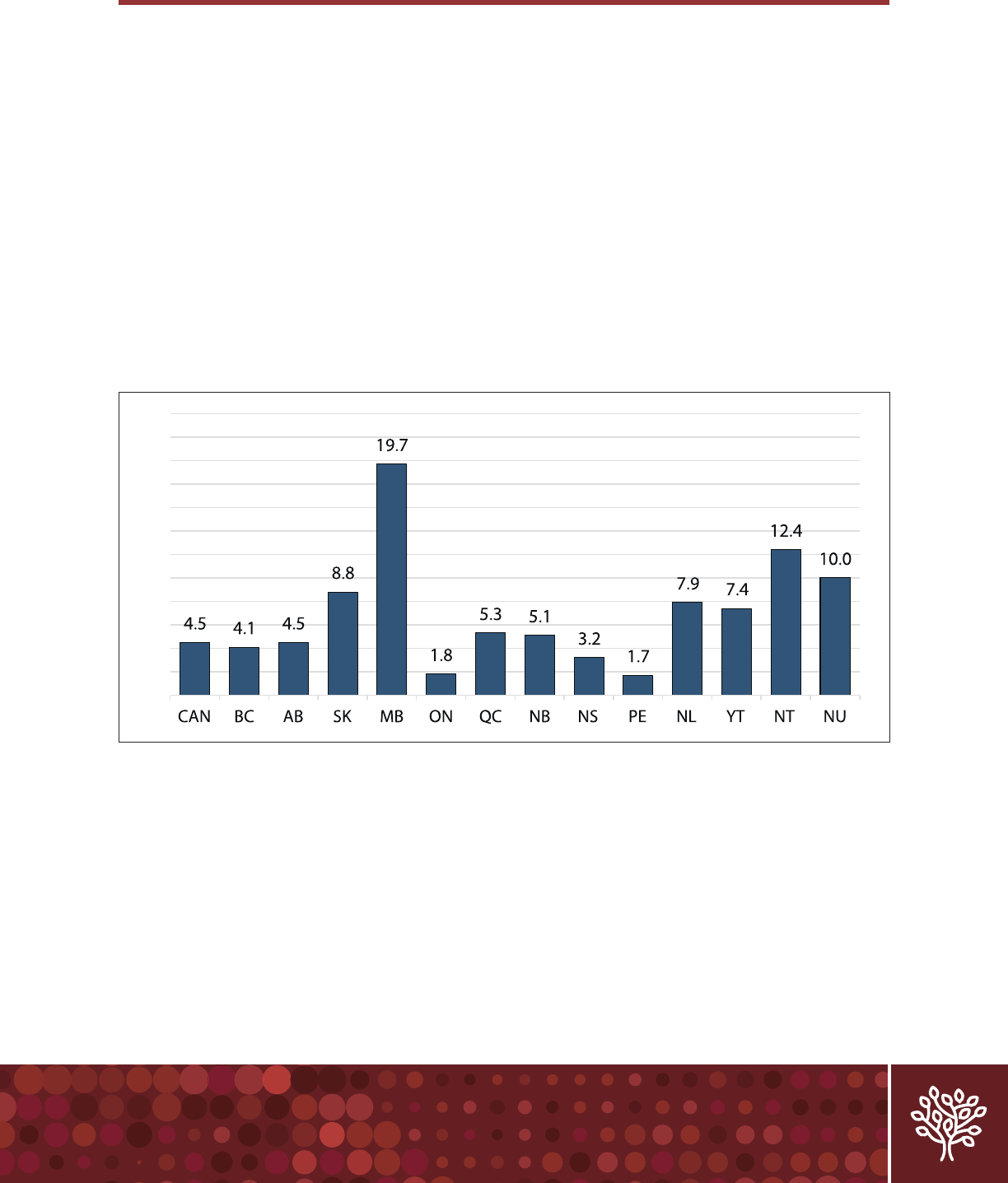
FAMILIES COUNT 2024 | FAMILY STRUCTURE
28 | THE VANIER INSTITUTE OF THE FAMILY
an extension of racist policies that sought
to assimilate Indigenous people.
76
The practice of removing Indigenous children
from their families continues at high rates
today, which has led many to call modern
child welfare practices the “Millennium
Scoop.” Similar to the residential school
system, this practice uproots children from
their families and communities, and away
from loving child-rearing practices, parental
role models, their cultures, and their identities.
Some steps have been taken to reduce the
number of Indigenous children and youth
in care. Developed in consultation with
Indigenous peoples, the 2019 Act respecting
First Nations, Inuit and Métis children,
youth and families
73
affirms the rights of
Indigenous peoples to exercise jurisdiction
over child and family services. It also allows
Indigenous groups, who wish to do so, to
design and deliver child and family services
solutions that best suit their needs.
Rate per 1,000 children
Rate of children under 15 in foster care, Canada, provinces and territories, 2021
Source: Black, T., Trocmé, N., Fallon, B., & Houston, E. (2022). Children in foster care in Canada in 2016 & 2021.
75

FAMILIES COUNT 2024 | FAMILY STRUCTURE
29 | THE VANIER INSTITUTE OF THE FAMILY
When the first edition of Families Count was
published in 1994, the most recent census
data showed that one-third (33.0%) of the
population in Canada aged 65 and older were
widowed in 1991.
7
By 2021, this had fallen to
one in five (20.0%).
1
Across all age groups,
there are proportionally fewer people who
are widowed today than in the early 1990s.
A variety of factors have driven the decline in
the proportion of widowed people and for the
tendency for widowhood to occur later in life.
Improved healthcare and advances in medical
science have contributed to increased life
expectancy. Declining crude mortality rates
over the last half century (i.e., the number
of deaths in a given year per 100,000
population) have also reduced the likelihood
of a spouse dying at a younger age.
78
The declining likelihood of becoming widowed
over the last 30 years has been most evident
among older women. This is the result of the
closing gender gap in life expectancy over the
last several decades. Between 1980–1982 and
2020–2022, life expectancy at birth increased
from 79.1 years to 83.8 years for women, and
from 72.0 years to 79.3 years among men.
79
As a result, the gap in life expectancy between
women and men fell from 7.1 years to
4.5 years during this period.
In 2021, 47.1% of women aged 80 to 84
were widowed, compared with 16.6% of
men in the same age group.
1
It is not until
men reach 95 years of age and older that
most are widowed. Also, men tend to be
older than women in most heterosexual
marriages, and the average age difference
between spouses or partners has reduced
in recent decades.
80
This has contributed to
the declining percentage of widowed
people—particularly women.
Another contributing factor is declining
marriage rates. “Widowed” includes people
whose legally married spouse has died and
who have not remarried. Common-law
families are therefore not included in
widowhood statistics, because the
partners were never legally married.
Why this matters
In addition to feelings of grief, sadness,
and loneliness, being widowed can have
major consequences for the grieving
partners and their families. Widowhood
has economic implications, since it is often
accompanied by additional expenses, such
as funeral costs and expenses related to
changes in living arrangements. Losing a
spouse also often means losing a source
The percentage of older adults
who are widowed has declined
14

FAMILIES COUNT 2024 | FAMILY STRUCTURE
30 | THE VANIER INSTITUTE OF THE FAMILY
of family income, particularly for older
people who may have limited workforce
opportunities and/or who had relied
on their spouses’ income or pension
benefits. For younger families, the
surviving spouse may experience
difficulties in combining earning and
caregiving responsibilities while adjusting
to changing family dynamics during a
difficult time.
Various programs and initiatives are in
place to support the economic wellbeing of
widowed people, including survivor benefits
through the Canada Pension Plan (CPP) and
Old Age Security (OAS) programs. These
programs have helped to improve the
living standard of widowed older adults.
Research has shown that divorce has a
greater impact on living standards than
widowhood during retirement.
81
12.1
19.5
31.1
47.1
69.2
4.0
6.6
10.4
16.6
31.9
65–69 years 70–74 years 75–79 years 80–84 years 85+ years
Percentage
Women Men
Percentage of older adults who were widowed,
by gender and age group, Canada, 2021
Source: Statistics Canada. (2023, March 29). Marital
status, age group and gender: Canada, provinces and
territories and economic regions.
1
42.4
11.4
29.8
10.1
Women Men
Percentage
1991 2021
Percentage of the population aged 65 and
older who were widowed, by gender, Canada,
1991 and 2021
Sources: Statistics Canada. (1992). Population by age groups
(21a) and sex (3), showing marital status (6) – Canada,
provinces and territories, federal electoral districts and
enumeration areas.
7
Statistics Canada. (2023, March 29). Marital status, age
group and gender: Canada, provinces and territories and
economic regions.
1

FAMILIES COUNT 2024 | FAMILY STRUCTURE
31 | THE VANIER INSTITUTE OF THE FAMILY
References
1
Statistics Canada. (2023, March 29). Table 98-10-0132-01 Marital status, age group and gender: Canada, provinces and
territories and economic regions.
https://doi.org/10.25318/9810013201-eng
2
Statistics Canada. (1993, June 1). Table 97-570-X1991003 Population by age groups (21a) and sex (3), showing marital
status (6) – Canada, provinces and territories, census divisions and census subdivisions.
https://www150.statcan.gc.ca/n1/en/catalogue/97-570-X1991003
3
Statistics Canada. (2022, November 14). Table 39-10-0055-01 Number of marriages and nuptiality indicators.
https://doi.org/10.25318/3910005501-eng
4
Statistics Canada. (2022, November 14). “I don’t”: Historic decline in new marriages during the first year of the pandemic.
The Daily.
https://www150.statcan.gc.ca/n1/daily-quotidien/221114/dq221114b-eng.htm
5
Statistics Canada. (2022, July 13). State of the union: Canada leads the G7 with nearly one-quarter of couples living common
law, driven by Quebec. The Daily.
https://www150.statcan.gc.ca/n1/daily-quotidien/220713/dq220713b-eng.htm
6
Statistics Canada. (2022, July 13). Table 98-10-0123-01 Census family structure, presence of children and average number of
persons per census family: Canada, provinces and territories, census metropolitan areas and census agglomerations.
https://doi.org/10.25318/9810012301-eng
7
Statistics Canada. (1992). Table E9102 Population by age groups (21a) and sex (3), showing marital status (6) – Canada,
provinces and territories, federal electoral districts and enumeration areas.
https://www12.statcan.gc.ca/English/census91/data/tables/Rp-
eng.cfm?LANG=E&APATH=3&DETAIL=1&DIM=0&FL=A&FREE=1&GC=0&GID=0&GK=0&GRP=1&PID=86&PRID=0&PTYP
E=4&S=0&SHOWALL=No&SUB=0&Temporal=1991&THEME=101&VID=0&VNAMEE=&VNAMEF
8
Statistics Canada. (2022, November 14). Table 39-10-0056-01 Mean age and median age at marriage, by legal marital
status.
https://doi.org/10.25318/3910005601-eng
9
Clark, W., & Crompton, S. (2006, June 28). Till death do us part? The risk of first and second marriage dissolution. Canadian
Social Trends.
https://www150.statcan.gc.ca/n1/pub/11-008-x/2006001/9198-eng.htm
10
Statistics Canada. (2022, November 14). Table 39-10-0057-01 Number of persons who married in a given year and
marriage rate per 1,000 unmarried persons, by age group and legal marital status.
https://doi.org/10.25318/3910005701-eng
11
Statistics Canada. (2022, March 9). A fifty-year look at divorces in Canada, 1970 to 2020. The Daily.
https://www150.statcan.gc.ca/n1/daily-quotidien/220309/dq220309a-eng.htm
12
Statistics Canada. (2022, November 14). Table 39-10-0051-01 Number of divorces and divorce indicators.
https://doi.org/10.25318/3910005101-eng
13
Statistics Canada. (2021, November 5). Common-law status of person. Definitions, data sources, and methods.
https://www23.statcan.gc.ca/imdb/p3Var.pl?Function=DEC&Id=206980
14
Statistics Canada. (2022, July 13). Table 98-10-0136-01 Gender diversity status of couple family, type of union and presence
of children: Canada, provinces and territories, census metropolitan areas and census agglomerations.
https://doi.org/10.25318/9810013601-eng
15
Statistics Canada. (2019, May 1). Family Matters: Being common law, married, separated or divorced in Canada. The Daily.
https://www150.statcan.gc.ca/n1/daily-quotidien/190501/dq190501b-eng.htm
16
Statistics Canada. (1991). Table E9103 Persons in private households living in common-law unions by age groups (21a),
showing sex (3) – Canada, provinces and territories, federal electoral districts and enumeration areas.
https://www12.statcan.gc.ca/English/census91/data/tables/Rp-
eng.cfm?LANG=E&APATH=3&DETAIL=1&DIM=0&FL=A&FREE=1&GC=0&GID=0&GK=0&GRP=1&PID=87&PRID=0&PTYP
E=4&S=0&SHOWALL=No&SUB=0&Temporal=1991&THEME=101&VID=0&VNAMEE=&VNAMEF
17
Mitchell, J., & Day, L. L. (2021, October 21). For love or money? Why Canadian young adults marry … or don’t. Cardus.
https://www.cardus.ca/research/family/reports/for-love-or-money
18
Statistics Canada. (2023, September 15). Table 98-10-0292-01 Indigenous identity population by gender and age: Canada,
provinces and territories, census metropolitan areas and census agglomerations.
https://doi.org/10.25318/9810029201-eng

FAMILIES COUNT 2024 | FAMILY STRUCTURE
32 | THE VANIER INSTITUTE OF THE FAMILY
19
Breton, L., & Hilbrecht, M. (2023, November 24). The rights of common-law partners in Canada. The Vanier Institute of the
Family.
https://doi.org/10.61959/t210318a
20
Statistics Canada. (2008, February 19). Tables 97-553-X2006005 Number of children at home (8) and census family
structure (7) for the census families in private households of Canada, provinces, territories, census divisions, census
subdivisions and dissemination areas, 2006 census – 20% sample data.
https://www150.statcan.gc.ca/n1/en/catalogue/97-
553-X2006005
21
Statistics Canada. (2013, December 23). Number of children at home (8) and family structure (7A) for census families in
private households, for Canada, provinces and territories, 1981 to 2001 censuses – 20% sample data.
https://www12.statcan.gc.ca/English/census01/products/standard/themes/Rp-
eng.cfm?LANG=E&APATH=3&DETAIL=1&DIM=0&FL=A&FREE=1&GC=0&GID=0&GK=0&GRP=1&PID=55730&PRID=0&P
TYPE=55440&S=0&SHOWALL=No&SUB=0&Temporal=2006&THEME=39&VID=0&VNAMEE=&VNAMEF
22
Statistics Canada. (2018, May 30). Census family structure (7) and presence and ages of children (15) for census families
in private households of Canada, provinces and territories, census metropolitan areas and census agglomerations, 2016 and
2011 censuses – 100% data.
https://www12.statcan.gc.ca/census-recensement/2016/dp-pd/dt-td/Rp-
eng.cfm?LANG=E&APATH=3&DETAIL=0&DIM=0&FL=A&FREE=0&GC=0&GID=0&GK=0&GRP=1&PID=112462&PRID=10
&PTYPE=109445&S=0&SHOWALL=0&SUB=0&Temporal=2016&THEME=117&VID=0&VNAMEE=&VNAMEF=
23
Statistics Canada. (2019, February 20). Family matters: Couples who live apart. Infographics.
https://www150.statcan.gc.ca/n1/pub/11-627-m/11-627-m2019014-eng.htm
24
Turcotte, M. (2013, March). Living apart together. Insights on Canadian Society.
https://www150.statcan.gc.ca/n1/en/pub/75-006-x/2013001/article/11771-eng.pdf?st=0acKiDf9
25
De Jong Gierveld, J. (2015, August 24). Intra-couple caregiving of older adults living apart together: Commitment and
independence. Canadian Journal on Aging, 34(3), 356-365.
https://doi.org/10.1017/S0714980815000264
26
Tang, J., Galbraith, N., & Truong, J. (2019, March 6). Living alone in Canada. Insights on Canadian Society.
https://www150.statcan.gc.ca/n1/pub/75-006-x/2019001/article/00003-eng.htm
27
Alarie, M. (2023, December 8). Family and consensual non-monogamy: Parents’ perceptions of benefits and challenges.
Journal of Marriage and Family, 1(19).
https://doi.org/10.1111/jomf.12955
28
Boyd, J.-P. (2017, April 11). Polyamory in Canada: Research on an emerging family structure. The Vanier Institute of the Family.
https://vanierinstitute.ca/polyamory-in-canada-research-on-an-emerging-family-structure
29
Balzarini, R. N., Dharma, C., Kohut, T., Holmes, B. M., Campbell, L., Lehmiller, J. J., & Harman, J. J. (2018, June 18).
Demographic comparison of American individuals in polyamorous and monogamous relationships. The Journal of Sex
Research, 56(6), 681-694.
https://doi.org/10.1080/00224499.2018.1474333
30
Boyd, J.-P. (2016, August 24). Polyamorous families in Canada: Early results of new research from CRILF.
https://ablawg.ca/2016/08/24/polyamorous-canada-early-results-from-crilf
31
Lessard, M. (2020, December 1). Les amoureux sur les bancs publics: Le traitement juridique du polyamour en droit
québécois. Revue canadienne de droit familial 1, 32(1).
https://papers.ssrn.com/sol3/papers.cfm?abstract_id=3501938
32
British Columbia Birth Registration No. 2018-XX-XX5815, 2021 BCSC 767 (CanLII). (2021, April 23).
https://www.canlii.org/en/bc/bcsc/doc/2021/2021bcsc767/2021bcsc767.html
33
Landry, S., Arseneau, E., & Darling, E. K. (2021, June 1). “It’s a little bit tricky”: Results from the POLYamorous childbearing
and birth experiences study (POLYBABES). Archives of Sexual Behavior, 50(4), 1479-1490.
https://doi.org/10.1007/s10508-021-02025-5
34
Levine, E. C., Herbenick, D., Martinez, O., Fu, T.-C., & Dodge, B. (2018, April 25). Open relationships, nonconsensual
nonmonogamy, and monogamy among U.S. adults: Findings from the 2012 national survey of sexual health and behavior.
Archives of Sexual Behavior, 47(5), 1439-1450.
https://doi.org/10.1007/s10508-018-1178-7
35
Polyamproud. (2022). Our new flag. https://www.polyamproud.com/flag
36
The University of British Columbia. Pride flags. https://equity.ubc.ca/pride-flags
37
Statistics Canada. (2022, July 13). Table 98-10-0137-01 Census family status and household living arrangements, presence
of parent in household, age group and gender: Canada, provinces and territories, census metropolitan areas and census
agglomerations.
https://doi.org/10.25318/9810013701-eng

FAMILIES COUNT 2024 | FAMILY STRUCTURE
33 | THE VANIER INSTITUTE OF THE FAMILY
38
Statistics Canada. (2022, July 13). Home alone: More persons living solo than ever before, but roomies the fastest growing
household type. The Daily.
https://www150.statcan.gc.ca/n1/daily-quotidien/220713/dq220713a-eng.htm?indid=32985-4&indgeo=0
39
Milan, A. (2016, June 15). Diversity of young adults living with their parents. Insights on Canadian Society.
https://www150.statcan.gc.ca/n1/pub/75-006-x/2016001/article/14639-eng.htm
40
Statistics Canada. (2017, August 2). Young adults living with their parents in Canada in 2016. Census in Brief.
https://www12.statcan.gc.ca/census-recensement/2016/as-sa/98-200-x/2016008/98-200-x2016008-eng.cfm
41
Statistics Canada. (2022, July 13). Table 98-10-0138-01 Household type including multigenerational households and
structural type of dwelling: Canada, provinces and territories, census metropolitan areas and census agglomerations.
https://doi.org/10.25318/9810013801-eng
42
Statistics Canada. (2022, July 13). Table 98-10-0134-01 Census family status and household living arrangements,
household type of person, age group and gender: Canada, provinces and territories, census metropolitan areas and census
agglomerations.
https://doi.org/10.25318/9810013401-eng
43
Statistics Canada. (2022, September 21). Table 98-10-0278-01 Presence of grandparents in household by Indigenous
identity and residence by Indigenous geography: Canada, provinces and territories.
https://www150.statcan.gc.ca/t1/tbl1/en/cv.action?pid=9810027801
44
Statistics Canada. (2022, September 21). Housing conditions among First Nations people, Métis and Inuit in Canada from
the 2021 Census. Analytical products, 2021 Census.
https://www12.statcan.gc.ca/census-recensement/2021/as-sa/98-200-
X/2021007/98-200-X2021007-eng.cfm
45
Che-Alford, J., & Hamm, B. (1999, June 8). Under one roof: Three generations living together. Canadian Social Trends.
https://www150.statcan.gc.ca/n1/pub/11-008-x/1999001/article/4575-eng.pdf
46
Waterston, S., Grueger, B., Samson, L., Canadian Paediatric Society, & Community Paediatrics Committee. (2015, October 5).
Housing need in Canada: Healthy lives start at home. Paediatrics & Child Health, 20(7), 403–407.
https://doi.org/10.1093/pch/20.7.403
47
Vézina, M. (2012). Being a parent in a stepfamily: A profile. 2011 General Social Survey: Overview of Families in Canada.
https://www150.statcan.gc.ca/n1/pub/89-650-x/89-650-x2012002-eng.htm
48
Statistics Canada. (2022, July 13). Table 98-10-0124-01 Census family structure including detailed information on
stepfamilies, number of children, average number of children and age of youngest child: Canada, provinces and territories,
census metropolitan areas and census agglomerations.
https://doi.org/10.25318/9810012401-eng
49
Statistics Canada. (2012, September). Portrait of families and living arrangements in Canada. 2011 Analytical products.
https://www12.statcan.gc.ca/census-recensement/2011/as-sa/98-312-x/98-312-x2011001-eng.cfm
50
Statistics Canada. (2018, May 17). Fertility: Fewer children, older moms. Canadian Megatrends.
https://www150.statcan.gc.ca/n1/pub/11-630-x/11-630-x2014002-eng.htm
51
Statistics Canada. (2023, September 27). Table 13-10-0418-01 Crude birth rate, age-specific fertility rates and total fertility
rate (live births).
https://doi.org/10.25318/1310041801-eng
52
Statistics Canada. (2018). Table 1 Distribution of women and men, by age group and highest level of educational
attainment, Canada, 1990 and 2009.
https://www150.statcan.gc.ca/n1/pub/89-503-x/2010001/article/11542/tbl/tbl001-eng.htm
53
Statistics Canada. (2022, December 9). Table 98-10-0384-01 Highest level of education by census year: Canada, provinces
and territories, census metropolitan areas and census agglomerations.
https://doi.org/10.25318/9810038401-eng
54
Statistics Canada. (2024, January 5). Table 14-10-0327-01 Labour force characteristics by sex and detailed age group,
annual.
https://doi.org/10.25318/1410032701-eng
55
Fostik, A., & Galbraith, N. (2021, December 1). Changes in fertility intentions in response to the COVID-19 pandemic.
StatCan COVID-19: Data to Insights for a Better Canada.
https://www150.statcan.gc.ca/n1/pub/45-28-
0001/2021001/article/00041-eng.htm
56
Statistics Canada. (2020, September 29). Births, 2019. The Daily. https://www150.statcan.gc.ca/n1/daily-
quotidien/200929/dq200929e-eng.htm

FAMILIES COUNT 2024 | FAMILY STRUCTURE
34 | THE VANIER INSTITUTE OF THE FAMILY
57
Statistics Canada. (2012, September). Fifty years of families in Canada: 1961 to 2011. 2011 Analytical products.
https://www12.statcan.gc.ca/census-recensement/2011/as-sa/98-312-x/98-312-x2011003_1-eng.cfm
58
Statistics Canada. (2012). Families reference guide, 2011 Census. https://www12.statcan.gc.ca/census-
recensement/2011/ref/guides/98-312-x/98-312-x2011005-eng.cfm
59
Statistics Canada. (1996). Census families in private households by age groups of youngest never-married child at home
(10), showing family structure (7), for Canada, provinces, territories and census metropolitan areas, 1991 and 1996 censuses
(20% sample data).
https://www12.statcan.gc.ca/English/census96/data/tables/Rp-
eng.cfm?LANG=E&APATH=3&DETAIL=1&DIM=0&FL=A&FREE=1&GC=0&GID=0&GK=0&GRP=1&PID=1035&PRID=0&PT
YPE=89103&S=0&SHOWALL=No&SUB=0&Temporal=2006&THEME=24&VID=0&VNAMEE=&VNAMEF
60
Findlay, L. C., Wei, L., & Arim, R. (2021, August 25). Patterns of participation in early learning and child care among families
with potential socioeconomic disadvantages in Canada. Economic and Social Reports.
https://doi.org/10.25318/36280001202100800002-eng
61
Statistics Canada. (2022, November 9). Disaggregated trends in poverty from the 2021 Census of Population. Analytical
products, 2021 Census.
https://www12.statcan.gc.ca/census-recensement/2021/as-sa/98-200-X/2021009/98-200-
X2021009-eng.cfm
62
Children’s Aid Foundation of Canada. (2021, July 22). Adopting or fostering a child from the child welfare system in
Canada.
https://cafdn.org/stories/adopting-or-fostering-a-child-from-the-child-welfare-system-in-canada
63
Statistics Canada. (2017, May 8). Mother’s Day... by the numbers. The Daily.
https://www.statcan.gc.ca/en/dai/smr08/2017/smr08_216_2017#a10
64
Government of British Columbia. Ways to adopt in B.C. – Infant adoption. https://www2.gov.bc.ca/gov/content/life-
events/birth-adoption/adoptions/how-to-adopt-a-child/infant-adoption
65
Government of Alberta. Private adoption. https://www.alberta.ca/private-adoption
66
Government of Manitoba. Private adoption. https://www.gov.mb.ca/fs/childfam/private_adoption.html
67
Government of Ontario. Private domestic adoption. https://www.ontario.ca/page/private-domestic-adoption
68
Department of social development. (2024, January 8). Adopting a child or youth.
https://socialsupportsnb.ca/en/program/adopting-child-or-youth
69
Government of Canada. Adopt a child from abroad. https://www.canada.ca/en/immigration-refugees-
citizenship/services/canadians/adopt-child-abroad/processes.html
70
Conseil de gestion de l’assurance parentale. (2022, October). Profil des prestataires 2020.
https://cdn-contenu.quebec.ca/cdn-contenu/adm/min/emploi-solidarite-
sociale/conseil_gestion_assurance_parentale/statistiques/profil_prestataires/Profil-Prestataires-2020.pdf
71
McLeod, C., Davies, L., Fice, N., Bruijns, L., Cichocki, E., Doguoglu, H., & Stewart, H. (2019, May). Time to attach:
An argument in favour of EI attachment benefits.
http://works.bepress.com/carolyn-mcleod/57
72
Statistics Canada. (2022, July 13). Table 98-10-0135-01 Household and family characteristics of persons including detailed
information on stepfamilies, presence of grandparents in household, age group and gender: Canada, provinces and territories,
census metropolitan areas and census agglomerations.
https://doi.org/10.25318/9810013501-eng
73
Indigenous Services Canada. (2023, February 15). Reducing the number of Indigenous children in care.
https://www.sac-isc.gc.ca/eng/1541187352297/1541187392851
74
Statistics Canada. (2022, September 21). Indigenous population continues to grow and is much younger than the non-
Indigenous population, although the pace of growth has slowed. The Daily.
https://www150.statcan.gc.ca/n1/daily-quotidien/220921/dq220921a-eng.htm
75
Black, T., Trocmé, N., Fallon, B., & Houston, E. (2022). Children in foster care in Canada in 2016 & 2021.
https://cwrp.ca/publications/children-foster-care-canada-2016-2021
76
Ontario Human Rights Commission. (2018, January 8). Interrupted childhoods: Over-representation of Indigenous and
Black children in Ontario child welfare.
https://www.ohrc.on.ca/en/interrupted-childhoods

The Vanier Institute of the Family
94 Centrepointe Drive
Ottawa, Ontario K2G 6B1
info@vanierinstitute.ca
www.vanierinstitute.ca
How to cite this document:
The Vanier Institute of the Family. (2024). Family structure. In Families count 2024.
https://vanierinstitute.ca/families-count-2024/family-structure
Families Count 2024 is a publication of the Vanier Institute of the Family that provides accurate and timely
information on families and family life in Canada. Written in plain language, it features chapters on diverse
topics and trends that have shaped families in Canada. Its four sections (Family Structure, Family Work,
Family Identity, and Family Wellbeing) are guided by the
Family Diversities and Wellbeing Framework.
FAMILIES COUNT 2024 | FAMILY STRUCTURE
35 | THE VANIER INSTITUTE OF THE FAMILY
77
CBC Radio. (2018, January 25). The Millennium Scoop: Indigenous youth say care system repeats horrors of the past.
The Current.
https://www.cbc.ca/radio/thecurrent/a-special-edition-of-the-current-for-january-25-2018-1.4503172/the-
millennium-scoop-indigenous-youth-say-care-system-repeats-horrors-of-the-past-1.4503179
78
Decady, Y., & Greenberg, L. (2014, July). Ninety years of change in life expectancy. Health at a Glance.
https://www150.statcan.gc.ca/n1/pub/82-624-x/2014001/article/14009-eng.htm
79
Statistics Canada. (2023, November 27). Table 13-10-0114-01 Life expectancy and other elements of the complete life table,
three-year estimates, Canada, all provinces except Prince Edward Island.
https://doi.org/10.25318/1310011401-eng
80
Milan, A., Wong, I., & Vézina, M. (2014, February 24). Emerging trends in living arrangements and conjugal unions for
current and future seniors, 1981 to 2011. Insights on Canadian Society.
https://www150.statcan.gc.ca/n1/pub/75-006-
x/2014001/article/11904-eng.htm
81
Mehdi, T. (2023, May 8). A cross-cohort comparison of the economic impact of divorce and widowhood on seniors.
Economic and Social Reports.
https://doi.org/10.25318/36280001202300400003-eng
Note
Chapters 1 to 14 were written by Nathan Battams and Sophie Mathieu.
Acknowledgements
We gratefully acknowledge the contribution of Statistics Canada for reviewing the chapters in this section. For their reviews of
Chapters 6, 12, and 13, respectively, we wish to thank Áine Humble, Professor, Department of Family Studies and Gerontology,
Mount Saint Vincent University; Denise Whitehead, Professor and Chair, Department of Sexuality, Marriage, and Family Studies,
St. Jerome’s University; and Beverly Sabourin, former Vice-Provost (Indigenous Initiatives), Lakehead University, Thunder Bay,
and advocate for Indigenous rights.
This work is licensed under a Creative Commons
Attribution-Noncommercial 4.0 International license.
